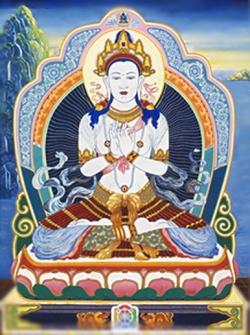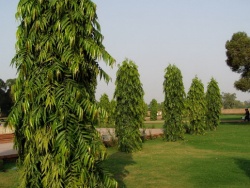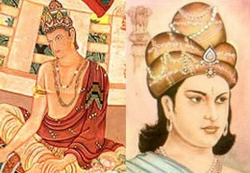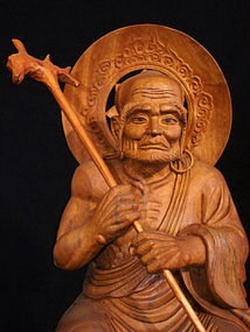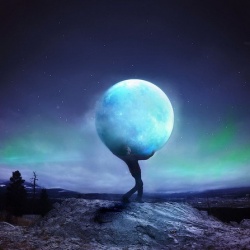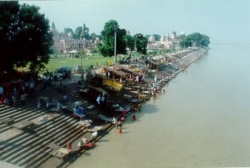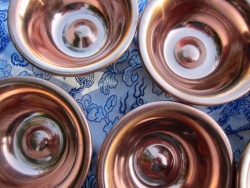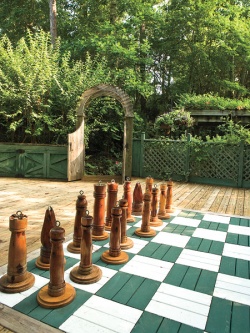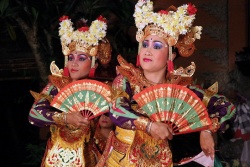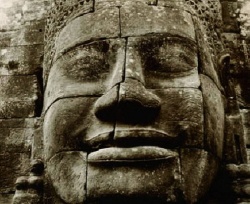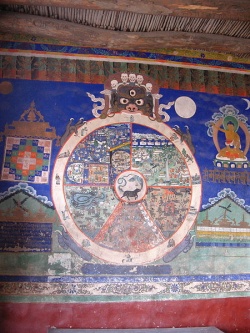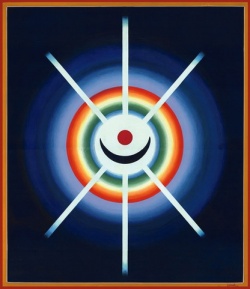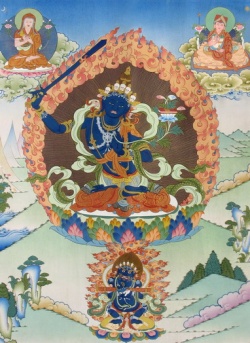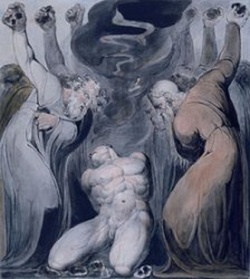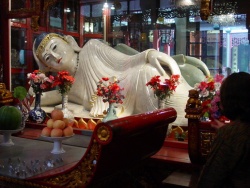Difference between revisions of "Life and Teaching of Nepalese Siddha Advayavajra"
(Created page with "<poem> by Min Bahadur Shakya Buddhist Himalaya VOL. V NO. I & II 1993 1993 1. Birth and Parentage Advayavajra was born in a village, named Jhotakar...") |
|||
| (4 intermediate revisions by the same user not shown) | |||
| Line 1: | Line 1: | ||
| + | [[File:Ochana_298.jpg |thumb|250px|]] | ||
<poem> | <poem> | ||
by Min Bahadur [[Shakya]] | by Min Bahadur [[Shakya]] | ||
| − | + | [[File:Ashoka tree.jpg|thumb|250px|]] | |
[[Buddhist]] [[Himalaya]] VOL. V NO. I & II 1993 | [[Buddhist]] [[Himalaya]] VOL. V NO. I & II 1993 | ||
1993 | 1993 | ||
| − | + | [[File:Ashoka14.jpg|thumb|250px|]] | |
1. [[Birth]] and Parentage | 1. [[Birth]] and Parentage | ||
| − | Advayavajra was born in a village, named Jhotakarani near the city of [[ | + | [[Advayavajra]] was born in a village, named Jhotakarani near the city of [[Kapilavastu]], [[Nepal]]. His family [[name]] was Damodar. His [[parents]] were [[Brahmans]]. His fathers [[name]] was Nanuka and that of mother was [[Savitri]]. |
| − | + | [[File:Asita00.jpg|thumb|250px|]] | |
2. [[Education]] | 2. [[Education]] | ||
| − | + | [[File:Astringent).jpg|thumb|250px|]] | |
| − | While eleven years old Damodar became the [[disciple]] of an Ekadandi with whom he studied half the portion of Samveda and was named Amritabodha. Then he went to a village, named Likati famed for its [[scholars]] and studied the Panini [[Grammar]] and mastered all Brahmanicla treatises within seven years. At that [[time]] he was only eighteen years old. It was natural for him to come in [[contact]] with the [[Buddhist monk]] [[scholars]] as he was a native of [[Buddha's]] [[birth]] place. He became restless for further studies of [[Buddhist scriptures]] and thus went to meet [[Naropa]] at Vikramashila [[monastery]]. Under this [[scholar]] [[Pandit]] [[Naropa]] he studied the [[logical]] treatise of | + | While eleven years old Damodar became the [[disciple]] of an Ekadandi with whom he studied half the portion of Samveda and was named [[Amritabodha]]. Then he went to a village, named Likati famed for its [[scholars]] and studied the [[Panini]] [[Grammar]] and mastered all Brahmanicla treatises within seven years. At that [[time]] he was only eighteen years old. It was natural for him to come in [[contact]] with the [[Buddhist monk]] [[scholars]] as he was a native of [[Buddha's]] [[birth]] place. He became restless for further studies of [[Buddhist scriptures]] and thus went to meet [[Naropa]] at [[Vikramashila]] [[monastery]]. Under this [[scholar]] [[Pandit]] [[Naropa]] he studied the [[logical]] treatise of [[Dignaaga]] and [[Dharmakirti]], [[Madhyamika]] [[philosophy]] of [[Nagarjuna]], [[doctrinal]] interpretations of [[Prajnaparamita]] for complete two years. Thereafter he dwelt for five years with [[Ragavajra]], who knew the treatises of the [[mantra]]. He also studied for one year the system of [[vijnanavada]], namely [[Nirakaravyavastha]] under the feet of [[Mahasiddha]] [[Ratnakara]] [[Santi]]. |
| − | + | [[File:AtSzA.jpg|thumb|250px|]] | |
| − | Both of these [[philosophers]] {{Wiki|saints}} were at Vikramashila [[monastery]]. Bur [[Naropa]] sometimes lived at pulahari too. In the same way Ratnakarasanti used to travel as fare as to Simhaladvipa. Therefore Amritabodha must have learned [[Buddhist philosophy]] from these [[philosopher]] {{Wiki|saints}}. He stayed Vikramashila for two years and learnt the unique piece of [[logic]] namely Ksanabhangadhyaya worded out by Jnanasrimitra, a learned logician. Up to twenty seven years of his age, he was not yet made a fully [[ordained]] [[monk]] according to the rules of the [[Buddhist]] [[Sangha]]. He went to Vikramashila and became an [[ordained]] [[monk]] according to the [[Sammitiya]] [[Nikaya]] [[traditions]] and was named Maitrigupta. (1) | + | Both of these [[philosophers]] {{Wiki|saints}} were at [[Vikramashila]] [[monastery]]. Bur [[Naropa]] sometimes lived at [[pulahari]] too. In the same way [[Ratnakarasanti]] used to travel as fare as to [[Simhaladvipa]]. Therefore [[Amritabodha]] must have learned [[Buddhist philosophy]] from these [[philosopher]] {{Wiki|saints}}. He stayed [[Vikramashila]] for two years and learnt the unique piece of [[logic]] namely [[Ksanabhangadhyaya]] worded out by [[Jnanasrimitra]], a learned [[logician]]. Up to twenty seven years of his age, he was not yet made a fully [[ordained]] [[monk]] according to the rules of the [[Buddhist]] [[Sangha]]. He went to [[Vikramashila]] and became an [[ordained]] [[monk]] according to the [[Sammitiya]] [[Nikaya]] [[traditions]] and was named [[Maitrigupta]]. (1) |
| − | Two [[Kagyu]] histories describes the [[conversion]] of Amritabodha in slight different [[manner]]: dpa"-bo Tsug lag (2)-"After completing the study of [[grammar]], he debated with [[Naropa]], who was victorious; so he served that [[teacher]]. After completing the study of {{Wiki|brahmanical}} rules and observances he took [[ordination]] under Ratnakarsanti. He became known as [[Maitri]] "[[loving]] one". He was unmatched in his erudition of the five fields of {{Wiki|learning}}. | + | Two [[Kagyu]] histories describes the [[conversion]] of [[Amritabodha]] in slight different [[manner]]: dpa"-bo Tsug lag (2)-"After completing the study of [[grammar]], he [[debated]] with [[Naropa]], who was victorious; so he served that [[teacher]]. After completing the study of {{Wiki|brahmanical}} rules and observances he took [[ordination]] under Ratnakarsanti. He became known as [[Maitri]] "[[loving]] one". He was unmatched in his erudition of the five fields of {{Wiki|learning}}. |
| − | The historian Padmakarpo provides still more detail (3): His paternal aunt was [[consort]] to [[Naropa]]. She said to him, "Heterodox [[doctrine]] conduces to [[achievement]] it this [[life]] or in [[heaven]], but it does not transcend [[Samsara]]; that is why it is not [[Buddhism]] Listen therefore to the [[doctrines]] of {{Wiki|Sri}} [[Naropa]]." and she said," [[Debate]] with him and let the one is defeated by converted" Led to [[Naropa]], he laid a weight with him on his [[teaching]], and debated. [[Naropa]] was victorious, and he ([[Maitripa]]) cut of his [[robes]] of {{Wiki|heterodoxy}}. He was named Dharmabodhi. He was initiated into Samvara, [[Hevajra]] and so forth. His [[Tantric]] [[name]] was [[Vajra]] [[raga]]. He learned much [[philosophy]] or [[logic]] and [[tantra]]. He was told, Now let you resort to one [[consort]] and cultivate yourself in the {{Wiki|forest}} hills. He replied," I seek no [[mudra]]. I will not cultivate in the {{Wiki|forest}} hills. Let me attend {{Wiki|eminent}} lectures." So he joined Trtacintamani, [[teacher]] of Ratnakarasanti. There he heard [[Mind-only]] [[philosophy]] for one year. Then in the land of Kapaki he met [[Santipa]] and took higher [[ordination]] he was named Maitrigupta. | + | The historian [[Padmakarpo]] provides still more detail (3): His paternal aunt was [[consort]] to [[Naropa]]. She said to him, "{{Wiki|Heterodox}} [[doctrine]] conduces to [[achievement]] it this [[life]] or in [[heaven]], but it does not transcend [[Samsara]]; that is why it is not [[Buddhism]] Listen therefore to the [[doctrines]] of {{Wiki|Sri}} [[Naropa]]." and she said," [[Debate]] with him and let the one is defeated by converted" Led to [[Naropa]], he laid a weight with him on his [[teaching]], and [[debated]]. [[Naropa]] was victorious, and he ([[Maitripa]]) cut of his [[robes]] of {{Wiki|heterodoxy}}. He was named [[Dharmabodhi]]. He was initiated into [[Samvara]], [[Hevajra]] and so forth. His [[Tantric]] [[name]] was [[Vajra]] [[raga]]. He learned much [[philosophy]] or [[logic]] and [[tantra]]. He was told, Now let you resort to one [[consort]] and cultivate yourself in the {{Wiki|forest}} hills. He replied," I seek no [[mudra]]. I will not cultivate in the {{Wiki|forest}} hills. Let me attend {{Wiki|eminent}} lectures." So he joined [[Trtacintamani]], [[teacher]] of [[Ratnakarasanti]]. There he heard [[Mind-only]] [[philosophy]] for one year. Then in the land of Kapaki he met [[Santipa]] and took higher [[ordination]] he was named [[Maitrigupta]]. |
| − | + | [[File:Avatarbuddha.jpg|thumb|250px|]] | |
3. [[Renunciation]] of [[monastic]] [[life]] | 3. [[Renunciation]] of [[monastic]] [[life]] | ||
| − | + | [[File:Ayodhya01i.jpg|thumb|250px|]] | |
| − | For four years to Vikramapur he studied [[Sutra]], [[Abhidharma]], and [[vinaya]]. In his twenty eight years of age he [[desired]] to be a [[siddha]]. According to the Pancakrama Tarapaddhati, he recited ten million japas along with caturmudra. Consequently, Bhattaraka [[Siddha]] Savarpada appeared in his [[dream]] and instructed him to visit the [[abode]] of Khasarpana. He stayed there for one year and again appeared in his [[dream]] and instructed him to visit {{Wiki|South}} [[Indian]] [[tantric]] [[Buddhist]] centers around the mountains of Mahabhanga and Cittavishrama where the [[Siddha]] Savarpa used to reside. He also learnt that during trips he would be accompanied by a [[Buddhist]] [[saint]] named Sagardutta of the {{Wiki|Radha}} region of {{Wiki|West}} {{Wiki|Bengal}}. | + | For four years to Vikramapur he studied [[Sutra]], [[Abhidharma]], and [[vinaya]]. In his twenty eight years of age he [[desired]] to be a [[siddha]]. According to the [[Pancakrama]] [[Tarapaddhati]], he recited ten million [[japas]] along with [[caturmudra]]. Consequently, Bhattaraka [[Siddha]] Savarpada appeared in his [[dream]] and instructed him to visit the [[abode]] of [[Khasarpana]]. He stayed there for one year and again appeared in his [[dream]] and instructed him to visit {{Wiki|South}} [[Indian]] [[tantric]] [[Buddhist]] centers around the [[mountains]] of Mahabhanga and Cittavishrama where the [[Siddha]] Savarpa used to reside. He also learnt that during trips he would be accompanied by a [[Buddhist]] [[saint]] named Sagardutta of the {{Wiki|Radha}} region of {{Wiki|West}} {{Wiki|Bengal}}. |
| − | Here the historian Padmakarpo(4) reports the dispute with Ratnakarasanti, [[Maitripa]] expounds a [[Madhyamika]] [[view]] point opposed to his teacher's [[mind-only]] [[philosophy]] There at [[maitripa]] upheld "not taking a stand". [[Santipa]] upheld "the aspect is false". They held a [[discussion]] and since [[Maitripa]] upheld what was right, the [[teacher]] was angered; he stripped of his [[religious]] [[robes]] and threw them out the door [[Maitripa]] salvaged some bits of cloth from pile of sweepings in the door way and stayed far from there, in peared a [[beautiful]] girl of sixteen years. She declared," Avadhutipa, do not stay here. In the {{Wiki|East}}, in the [[monastery]] of Khasarpana, dwells [[Avalokiteshvara]]. You will receive a {{Wiki|prophecy}} by him" and then she disappeared. From that [[sleeping]] place he went by stages to Khasarpana and dwelt there praying to the great [[compassionate]] one. A year passed. He fell into a [[light]] [[sleep]] in the pre-down, and a stiff white man appeared in a [[dream]]. He said, Avadhutipa, do not stay here. Go to the {{Wiki|south}}. At a place five and a half months distant from here called Sriparvat-Manobhanga Cittavishrama dwells the [[lord]] of [[yogins]] Savari and [[consorts]]. Go there, and all your incomprehension, wrong [[thinking]] and [[doubt]] will be dispelled. "Then he took the [[name]] Avadhutipa. | + | Here the historian [[Padmakarpo]](4) reports the dispute with [[Ratnakarasanti]], [[Maitripa]] expounds a [[Madhyamika]] [[view]] point opposed to his [[teacher's]] [[mind-only]] [[philosophy]] There at [[maitripa]] upheld "not taking a stand". [[Santipa]] upheld "the aspect is false". They held a [[discussion]] and since [[Maitripa]] upheld what was right, the [[teacher]] was angered; he stripped of his [[religious]] [[robes]] and threw them out the door [[Maitripa]] salvaged some bits of cloth from pile of sweepings in the door way and stayed far from there, in peared a [[beautiful]] girl of sixteen years. She declared," [[Avadhutipa]], do not stay here. In the {{Wiki|East}}, in the [[monastery]] of [[Khasarpana]], dwells [[Avalokiteshvara]]. You will receive a {{Wiki|prophecy}} by him" and then she disappeared. From that [[sleeping]] place he went by stages to [[Khasarpana]] and dwelt there praying to the great [[compassionate]] one. A year passed. He fell into a [[light]] [[sleep]] in the pre-down, and a stiff white man appeared in a [[dream]]. He said, [[Avadhutipa]], do not stay here. Go to the {{Wiki|south}}. At a place five and a half months distant from here called Sriparvat-Manobhanga Cittavishrama dwells the [[lord]] of [[yogins]] [[Savari]] and [[consorts]]. Go there, and all your incomprehension, wrong [[thinking]] and [[doubt]] will be dispelled. "Then he took the [[name]] [[Avadhutipa]]. |
| − | + | [[File:B9.jpg|thumb|250px|]] | |
4. Story of the expulsion of [[Maitripa]] by [[Atisha]] | 4. Story of the expulsion of [[Maitripa]] by [[Atisha]] | ||
| − | + | [[File:Backyard-chess.jpg|thumb|250px|]] | |
While he performed the [[deeds]] of a [[Pandit]] and while his [[siddha]] practices flourished, he saw the visage of [[Vajrayogini]]. When he [[realized]] that he should get acquainted with [[meditational]] practice, and while he was studying all the inner secret studies, a [[novice]] [[monk]] saw him and a woman drinking bear together and disputes arose within the [[monastic community]] over it. The [[Acarya]] spewed up milk, and as the [[novice]] drew near, he vomited up beer with no explanation for his [[action]]. Furthermore, once when the proctors and the [[rest]] had heard of this and come for him, the beer turned into milk and the woman become {{Wiki|invisible}} or, as it is said, changed it a [[ritual]] [[bell]]. Later on while the [[monks]] were lying in ambush for him the [[Siddha]] was unable to disguise himself with [[mantras]], and so they expelled. He spread out a hide by the [[river]] Gantges and sat down. At that [[time]] the proctor was said to have been Atisha.(5) | While he performed the [[deeds]] of a [[Pandit]] and while his [[siddha]] practices flourished, he saw the visage of [[Vajrayogini]]. When he [[realized]] that he should get acquainted with [[meditational]] practice, and while he was studying all the inner secret studies, a [[novice]] [[monk]] saw him and a woman drinking bear together and disputes arose within the [[monastic community]] over it. The [[Acarya]] spewed up milk, and as the [[novice]] drew near, he vomited up beer with no explanation for his [[action]]. Furthermore, once when the proctors and the [[rest]] had heard of this and come for him, the beer turned into milk and the woman become {{Wiki|invisible}} or, as it is said, changed it a [[ritual]] [[bell]]. Later on while the [[monks]] were lying in ambush for him the [[Siddha]] was unable to disguise himself with [[mantras]], and so they expelled. He spread out a hide by the [[river]] Gantges and sat down. At that [[time]] the proctor was said to have been Atisha.(5) | ||
| − | + | [[File:Bad-breath.jpg|thumb|250px|]] | |
| − | Historian [[Lama]] [[Taranatha]] continues: There at Vikramashila his capabilities had become measureless yet he had but little [[comprehension]] of [[reality]], Following the prediction of an obligational [[deity]], he proceeded to Sriparvat to seek Savari.(6) | + | Historian [[Lama]] [[Taranatha]] continues: There at [[Vikramashila]] his capabilities had become measureless yet he had but little [[comprehension]] of [[reality]], Following the {{Wiki|prediction}} of an obligational [[deity]], he proceeded to Sriparvat to seek Savari.(6) |
| − | + | [[File:Bali-Danse04a.jpg|thumb|250px|]] | |
5. Quest | 5. Quest | ||
| − | + | [[File:Bayon.jpg|thumb|250px|]] | |
| − | On his way to {{Wiki|South India}} he met Sagardutta at {{Wiki|Radha}} region and both proceeded forward. He could not find these two mountains up to {{Wiki|Orissa}}, He then went to Dhanyakataka and stayed there for one year Now Maitrigupta was more that thirty years old. He then went to Vaktpodu where he recited [[Tara]] [[sadhana]]. After one month Savarpa reappeared in his [[dream]] and said: | + | On his way to {{Wiki|South India}} he met Sagardutta at {{Wiki|Radha}} region and both proceeded forward. He could not find these two [[mountains]] up to {{Wiki|Orissa}}, He then went to [[Wikipedia:Dharanikota|Dhanyakataka]] and stayed there for one year Now [[Maitrigupta]] was more that thirty years old. He then went to Vaktpodu where he recited [[Tara]] [[sadhana]]. After one month Savarpa reappeared in his [[dream]] and said: |
| − | "To North-west from here there are mountains namely Mahabhanga and Cittavishrama". Then he, accompanied by a group of travellers marched forward for fifteen days and he came to know from his fellow traveller that he would possibly find these two mountains next day. A Next day he reached the spot as he [[desired]] and was himself very glad. He practiced [[fasting]] and [[offered]] Ten [[Mandalas]] everyday and [[meditated]] deligently. In the seventh day Savarpa appeared in his [[dream]]. All the same he was not completely satisfied. At the tenth day when Maitigupta determined to commit {{Wiki|suicide}} by cutting his {{Wiki|throat}}, just at this critical moment he got the [[vision]] of [[Siddha]] Savarpa in [[person]]. | + | "To North-west from here there are [[mountains]] namely Mahabhanga and Cittavishrama". Then he, accompanied by a group of travellers marched forward for fifteen days and he came to know from his fellow traveller that he would possibly find these two [[mountains]] next day. A Next day he reached the spot as he [[desired]] and was himself very glad. He practiced [[fasting]] and [[offered]] Ten [[Mandalas]] everyday and [[meditated]] deligently. In the seventh day Savarpa appeared in his [[dream]]. All the same he was not completely satisfied. At the tenth day when Maitigupta determined to commit {{Wiki|suicide}} by cutting his {{Wiki|throat}}, just at this critical moment he got the [[vision]] of [[Siddha]] Savarpa in [[person]]. |
| − | + | [[File:Bhavacakra Thikse.jpg|thumb|250px|]] | |
6. [[Guru's]] instruction | 6. [[Guru's]] instruction | ||
| − | [[Guru]] Savarpa himself gave him [[initiation]] in [[tantra]] lore and was named Advayavajra. Savarpa instructed him on Pancakrama(7) and Caturmudra(8) for twelve days. He also heard sermons for five more days on it. At that [[time]] two {{Wiki|female}} [[Buddhist]] tantrics named Padmavali and Jnanavali were playing the musical instruments Vina. | + | [[Guru]] Savarpa himself gave him [[initiation]] in [[tantra]] lore and was named [[Advayavajra]]. Savarpa instructed him on Pancakrama(7) and Caturmudra(8) for twelve days. He also heard sermons for five more days on it. At that [[time]] two {{Wiki|female}} [[Buddhist]] tantrics named Padmavali and Jnanavali were playing the musical instruments [[Vina]]. |
| − | At one [[time]] Advayavajra was asked to perform kayavyuha [[Perfection]] which he failed to demonstrate but Sagardutta accomplished it without difficulty. On questioning the [[reasons]] for inability in performing this [[tantric]] feat, Advayavajra come to know his inherent confusion and misunderstanding regarding [[perfection]] in [[Tantras]]. He was also informed that he would not get the [[perfection]] in his [[life]] [[time]]. Then he was advised to [[meditate]] over [[Vajrayogini]], a {{Wiki|female}} [[Buddhist]] [[deity]]. Instructing him thus he disappeared. | + | At one [[time]] [[Advayavajra]] was asked to perform kayavyuha [[Perfection]] which he failed to demonstrate but Sagardutta accomplished it without difficulty. On questioning the [[reasons]] for inability in performing this [[tantric]] feat, [[Advayavajra]] come to know his [[inherent]] {{Wiki|confusion}} and misunderstanding regarding [[perfection]] in [[Tantras]]. He was also informed that he would not get the [[perfection]] in his [[life]] [[time]]. Then he was advised to [[meditate]] over [[Vajrayogini]], a {{Wiki|female}} [[Buddhist]] [[deity]]. Instructing him thus he disappeared. |
Closed to these events the historian dPa'-bo-gtsug lag (9) narrates thus, | Closed to these events the historian dPa'-bo-gtsug lag (9) narrates thus, | ||
| − | + | [[File:Bindu554.jpg|thumb|250px|]] | |
| − | "He ate the fruit of [[trees]] and searched. Falling ill then, he could not find that for which he searched. [[Thinking]] of advice give for the [[intermediate state]], he prepared to commit {{Wiki|suicide}}. Just then Sakara saw Savari, as in the [[dream]], and called out. Prostrating himself [[Maitripa]] cried," I have been this way forever worn ort in {{Wiki|being}} blocked from you by obstruction. I an in bondage whether I see you or not, I will be {{Wiki|liberated}} whether I see you or not and so forth, whereby there arose a special [[concentration]]. | + | "He ate the fruit of [[trees]] and searched. Falling ill then, he could not find that for which he searched. [[Thinking]] of advice give for the [[intermediate state]], he prepared to commit {{Wiki|suicide}}. Just then [[Sakara]] saw [[Savari]], as in the [[dream]], and called out. [[Prostrating]] himself [[Maitripa]] cried," I have been this way forever worn ort in {{Wiki|being}} blocked from you by obstruction. I an in bondage whether I see you or not, I will be {{Wiki|liberated}} whether I see you or not and so forth, whereby there arose a special [[concentration]]. |
| − | + | [[File:Black Manjushri kl.jpg|thumb|250px|]] | |
| − | He composed many texts, including four [[mudra]] instructions, the Doha and the Twenty verses on the [[Mahayana]]. Sakara was {{Wiki|liberated}} and disappeared. One day she shot an arrow and slew a wild ping that was going through the {{Wiki|forest}}. When he recoiled at that she declared: | + | He composed many texts, including four [[mudra]] instructions, the [[Doha]] and the Twenty verses on the [[Mahayana]]. [[Sakara]] was {{Wiki|liberated}} and disappeared. One day she shot an arrow and slew a wild ping that was going through the {{Wiki|forest}}. When he recoiled at that she declared: |
| − | + | [[File:Blashphemy.jpg|thumb|250px|]] | |
"In the {{Wiki|forest}} of [[Samsara]] that has no [[arising]] | "In the {{Wiki|forest}} of [[Samsara]] that has no [[arising]] | ||
Runs the {{Wiki|boar}} of [[ignorance]] | Runs the {{Wiki|boar}} of [[ignorance]] | ||
| Line 49: | Line 50: | ||
and she disappeared. | and she disappeared. | ||
Then he prayed" | Then he prayed" | ||
| − | + | [[File:Chin ple.jpg|thumb|250px|]] | |
| − | with this [[physical body]] born of [[karma]]. I lack the [[fortune]] of the [[teaching]]. Let an [[emanation body]] go to a low class village known as Dhuti, for in it are found two old {{Wiki|female}} novices flanking one {{Wiki|male}} [[novice]]. And there he eliminated all false imputation in regard to the [[meditation]] instruction. Once, when he had awaked from [[sleep]], he found that he had forgotten all the [[doctrines]] he had learned." I must kill myself" he [[thought]], and Savari came in [[person]] through sky Savari declared. | + | with this [[physical body]] born of [[karma]]. I lack the [[fortune]] of the [[teaching]]. Let an [[emanation body]] go to a low class village known as Dhuti, for in it are found two old {{Wiki|female}} novices flanking one {{Wiki|male}} [[novice]]. And there he eliminated all false [[imputation]] in regard to the [[meditation]] instruction. Once, when he had awaked from [[sleep]], he found that he had forgotten all the [[doctrines]] he had learned." I must kill myself" he [[thought]], and [[Savari]] came in [[person]] through sky [[Savari]] declared. |
| − | + | [[File:Blessing1.jpg|thumb|250px|]] | |
"Where does one find the [[knowing]] | "Where does one find the [[knowing]] | ||
of [[doctrines]] that have not arisen? | of [[doctrines]] that have not arisen? | ||
| Line 58: | Line 59: | ||
and so forth. And he told him," | and so forth. And he told him," | ||
Go to the middle country.... | Go to the middle country.... | ||
| − | The historian Padmakarpo(10) on the other hand reports in more detail [[manner]] | + | The historian [[Padmakarpo]](10) on the other hand reports in more detail [[manner]] |
Seeking thereafter, a flask was placed to the {{Wiki|crown}} on his {{Wiki|head}} on the isle of [[Initiation]], and he was initiated as | Seeking thereafter, a flask was placed to the {{Wiki|crown}} on his {{Wiki|head}} on the isle of [[Initiation]], and he was initiated as | ||
| Line 70: | Line 71: | ||
Creates no {{Wiki|hope}} for any result whatsoever. | Creates no {{Wiki|hope}} for any result whatsoever. | ||
[[Mahamudra]] is to comprehend the [[essence]] of one's own [[thought]] | [[Mahamudra]] is to comprehend the [[essence]] of one's own [[thought]] | ||
| − | Appearance here and now is none other that one' own [[thought]] | + | [[Appearance]] here and now is none other that one' own [[thought]] |
No {{Wiki|status}}, such as the [[highest]] stage became evident, | No {{Wiki|status}}, such as the [[highest]] stage became evident, | ||
And he wondered whether obtainment of the [[initiation]] had been of | And he wondered whether obtainment of the [[initiation]] had been of | ||
| − | Any use, that is when Sakara said, | + | Any use, that is when [[Sakara]] said, |
| − | There is no bow, nor wild game nor {{Wiki|pig}}, | + | There is no [[bow]], nor wild game nor {{Wiki|pig}}, |
These are [[magical]] {{Wiki|creations}}. | These are [[magical]] {{Wiki|creations}}. | ||
The [[Jina]] Savara who dwells on the [[highest]] hill | The [[Jina]] Savara who dwells on the [[highest]] hill | ||
| Line 85: | Line 86: | ||
So he prophesied: | So he prophesied: | ||
| − | "For twelve days on [[Dharma]] preaching isle, you will seek and believe in the Anavila [[tantra]] like the sky the [[Guhyasamaja tantra]] like the ocean, the [[Hevajra Tantra]] like [[gnosis]], the [[Cakrasamvara tantra]] like a [[blessing]], the Namasangiti [[tantra]] like a key and all the cycle of doha [[doctrines]] of the [[teacher]] who has reached the [[perfection]]. Then you will return. Because you have doubted in me, you will not obtain the [[highest]] [[accomplishment]] in this [[life]]. Be received by [[Vajrayogini]] just before you [[die]], and in the [[intermediate state]] you will obtain the [[highest]] [[accomplishment]], And with that, he disappeared". Avakening, [[Maitripa]] found that the [[doctrines]] he had requested from Savari by {{Wiki|being}} over pondered, had all been forgotten. | + | "For twelve days on [[Dharma]] preaching isle, you will seek and believe in the Anavila [[tantra]] like the sky the [[Guhyasamaja tantra]] like the ocean, the [[Hevajra Tantra]] like [[gnosis]], the [[Cakrasamvara tantra]] like a [[blessing]], the [[Namasangiti]] [[tantra]] like a key and all the cycle of [[doha]] [[doctrines]] of the [[teacher]] who has reached the [[perfection]]. Then you will return. Because you have doubted in me, you will not obtain the [[highest]] [[accomplishment]] in this [[life]]. Be received by [[Vajrayogini]] just before you [[die]], and in the [[intermediate state]] you will obtain the [[highest]] [[accomplishment]], And with that, he disappeared". Avakening, [[Maitripa]] found that the [[doctrines]] he had requested from [[Savari]] by {{Wiki|being}} over pondered, had all been forgotten. |
to go back now" he [[thought]]" I would be ashamed before [[people]]. | to go back now" he [[thought]]" I would be ashamed before [[people]]. | ||
| − | Shall I kill myself.? Then Savari came before him and said, | + | Shall I kill myself.? Then [[Savari]] came before him and said, |
| − | "Maitipa, what's wrong?." | + | "[[Maitipa]], what's wrong?." |
I have forgotten all the [[doctrines]] and now [[contemplate]] {{Wiki|suicide}}" | I have forgotten all the [[doctrines]] and now [[contemplate]] {{Wiki|suicide}}" | ||
| − | Savari said, | + | [[Savari]] said, |
"Where can one find what is called | "Where can one find what is called | ||
{{Wiki|forgetting}} [[doctrines]] that have not arisen ? | {{Wiki|forgetting}} [[doctrines]] that have not arisen ? | ||
| Line 102: | Line 103: | ||
the very {{Wiki|nature}} of not having arisen. | the very {{Wiki|nature}} of not having arisen. | ||
| − | [[Comprehension]] dawned on Maitipa, he [[perceived]] the [[gnosis]] of five stages without obscuration. All the [[deeds]] of the "[[Teacher]] of the Three Mountains and his [[consorts]], he understood to be [[signs]] pointing to the [[essential]] meaning, He made his [[comprehension]] an [[offering]] to the [[Guru]], declaring: | + | [[Comprehension]] dawned on [[Maitipa]], he [[perceived]] the [[gnosis]] of [[five stages]] without {{Wiki|obscuration}}. All the [[deeds]] of the "[[Teacher]] of the Three [[Mountains]] and his [[consorts]], he understood to be [[signs]] pointing to the [[essential]] meaning, He made his [[comprehension]] an [[offering]] to the [[Guru]], declaring: |
"[[Phenomena]] are all [[emptiness]] | "[[Phenomena]] are all [[emptiness]] | ||
| Line 109: | Line 110: | ||
Apprehending the original meaning | Apprehending the original meaning | ||
However one acts is {{Wiki|liberated}}." | However one acts is {{Wiki|liberated}}." | ||
| − | I have comprehended the meaning that is free from obscuration, uncontrived, lacking the slightest [[self]] [[conscious]] [[mindfulness]]. Now there is no one I need question." | + | I have comprehended the meaning that is free from {{Wiki|obscuration}}, uncontrived, lacking the slightest [[self]] [[conscious]] [[mindfulness]]. Now there is no one I need question." |
| − | Taking the [[name]] of [[vajra]] of [[Non-duality]] (Advayavajra), he went on to the middle country | + | Taking the [[name]] of [[vajra]] of [[Non-duality]] ([[Advayavajra]]), he went on to the middle country |
7. The [[Teaching]] years | 7. The [[Teaching]] years | ||
| − | I si said that by [[virtue]] of [[initiation]], instruction, and subsequent advice, there eventually grew in his the intuitive [[vision]] of the things are. He became the chief of boundles number of [[dakas]] and [[dakinis]]. During this period he accomplished the eight accomplished the eight accomplishments beginning with the sword. Then he supposed he should become a [[wisdom]] holder ([[vidyadhara]]) who [[lives]] for an [[aeon]]. But when he had [[gathered]] the materials and [[signs]] of [[accomplishment]] had appeared, Savari made the forefinger pointing gesture and they were annihilated. He declared: "What do you expect to accomplish with that bit of [[illusion]]? Go and teach the [[philosophic]] meaning of the way things are, in detail". So he returned to the middle country Advayavajra following the instruction of this [[guru]] peruses a career of [[writing]] and [[teaching]]. He composed some works at Sriparvat. He was able to commit the [[insight]] to [[writing]]. He also [[gather]] [[disciples]]. Some are royalty and serve as partons, others are [[Tibetan]] like [[Guru]] [[Marpa]] and Carry out the teachings to preserve them for posterity. | + | I si said that by [[virtue]] of [[initiation]], instruction, and subsequent advice, there eventually grew in his the intuitive [[vision]] of the things are. He became the chief of boundles number of [[dakas]] and [[dakinis]]. During this period he accomplished the eight accomplished the eight accomplishments beginning with the sword. Then he supposed he should become a [[wisdom]] holder ([[vidyadhara]]) who [[lives]] for an [[aeon]]. But when he had [[gathered]] the materials and [[signs]] of [[accomplishment]] had appeared, [[Savari]] made the forefinger pointing gesture and they were annihilated. He declared: "What do you expect to [[accomplish]] with that bit of [[illusion]]? Go and teach the [[philosophic]] meaning of the way things are, in detail". So he returned to the middle country [[Advayavajra]] following the instruction of this [[guru]] peruses a career of [[writing]] and [[teaching]]. He composed some works at Sriparvat. He was able to commit the [[insight]] to [[writing]]. He also [[gather]] [[disciples]]. Some are royalty and serve as partons, others are [[Tibetan]] like [[Guru]] [[Marpa]] and Carry out the teachings to preserve them for posterity. |
Teachings to [[Guru]] [[Marpa]] | Teachings to [[Guru]] [[Marpa]] | ||
| Line 120: | Line 121: | ||
........"On his way, he asked some other travellers where [[Maitripa]] was living. They replied," he resides at the [[monastery]] of Blazing [[fire]] mountain. That [[path]] is difficult to travel; you had better not to go." | ........"On his way, he asked some other travellers where [[Maitripa]] was living. They replied," he resides at the [[monastery]] of Blazing [[fire]] mountain. That [[path]] is difficult to travel; you had better not to go." | ||
| − | [[Marpa]] [[thought]], "I am not looking for [[wealth]] in this [[life]]. Whether I [[die]] or not, I must seek the [[dharma]]. "He continued without hesitation, and in half a day arrived at the place where [[Maitripa]] was residing. He met [[Maitripa]] sitting in the shade of a Nyagrodha [[tree]], He felt great [[joy]] just like that of the [[Bodhisattva]] [[Sadaprarudita]] when he met the [[Bodhisattva]] Dahrmodgata. He [[offered]] full prostrations seven times, a gift of {{Wiki|gold}} and other things, and song this song praising the [[body]], [[speech]] and [[mind]] of the guru......The [[Master]] accepted him and gave complete abhisekas and the secret [[name]] Vajracitta. At that [[time]], [[Marpa]] made [[offerings]] to please the [[Guru]] and arranged feast tormas to please the [[dakinis]]. Thus, many wondrous [[signs]] arose. The [[guru]] gave him the oral instructions and [[transmission]] of [[mahamudra]]e | + | [[Marpa]] [[thought]], "I am not looking for [[wealth]] in this [[life]]. Whether I [[die]] or not, I must seek the [[dharma]]. "He continued without hesitation, and in half a day arrived at the place where [[Maitripa]] was residing. He met [[Maitripa]] sitting in the shade of a [[Nyagrodha]] [[tree]], He felt great [[joy]] just like that of the [[Bodhisattva]] [[Sadaprarudita]] when he met the [[Bodhisattva]] Dahrmodgata. He [[offered]] full [[prostrations]] seven times, a [[gift]] of {{Wiki|gold}} and other things, and song this song praising the [[body]], [[speech]] and [[mind]] of the guru......The [[Master]] accepted him and gave complete [[abhisekas]] and the secret [[name]] [[Vajracitta]]. At that [[time]], [[Marpa]] made [[offerings]] to please the [[Guru]] and arranged feast [[tormas]] to please the [[dakinis]]. Thus, many wondrous [[signs]] arose. The [[guru]] gave him the oral instructions and [[transmission]] of [[mahamudra]]e [[Arya]] [[manjusri]] [[name]] [[sangiti]] along with its commentary, and the [[dohas]] along with their explanation. [[Marpa's]] [[doubts]] were completely cleared away. When he practice d these teachings, {{Wiki|excellent}} [[experiences]] and realizations arose in his [[mind]], and so he was very [[pleased]]. At a gangcakra which he [[offered]] as thanks giving to the [[guru]], [[Marpa]] [[offered]] in song his [[realization]] and [[experience]]..... (12) |
[[Master]] [[Maitripa]] then [[sang]] this [[vajra]] song of twelve instructions to [[Marpa]]: | [[Master]] [[Maitripa]] then [[sang]] this [[vajra]] song of twelve instructions to [[Marpa]]: | ||
| Line 127: | Line 128: | ||
The [[root]] of [[non-duality]] will not be firm. | The [[root]] of [[non-duality]] will not be firm. | ||
If you do not develop unbiased [[compassion]], | If you do not develop unbiased [[compassion]], | ||
| − | The two rupakayas will not be attained. | + | The two [[rupakayas]] will not be [[attained]]. |
| − | If the three prajnas are not practiced | + | If the three [[prajnas]] are not practiced |
[[Realization]] will not arise. | [[Realization]] will not arise. | ||
| − | If you do not attend the Jetsun [[Guru]], | + | If you do not attend the [[Jetsun]] [[Guru]], |
| − | The two [[siddhis]] will not be attained. | + | The two [[siddhis]] will not be [[attained]]. |
If you cannot strike [[phenomena]] with [[mudra]] | If you cannot strike [[phenomena]] with [[mudra]] | ||
| Line 139: | Line 140: | ||
If [[thoughts]] of [[desire]] arise, | If [[thoughts]] of [[desire]] arise, | ||
You should act like a [[joyful]] [[elephant]]. | You should act like a [[joyful]] [[elephant]]. | ||
| − | If occasionally the Klesas arise, | + | If occasionally the [[Klesas]] arise, |
Look at the [[mind]] and [[meditate]] without {{Wiki|distraction}}, | Look at the [[mind]] and [[meditate]] without {{Wiki|distraction}}, | ||
If the [[mind]] is harmed by unfavourable [[conditions]], | If the [[mind]] is harmed by unfavourable [[conditions]], | ||
| − | Practice the four abhisekas continually. | + | Practice the four [[abhisekas]] continually. |
| − | If Klesas arise in your {{Wiki|being}}, | + | If [[Klesas]] arise in your {{Wiki|being}}, |
Remember the [[Guru's]] instructions. | Remember the [[Guru's]] instructions. | ||
| − | If you do not [[meditate]] in the union of utpattikrama and Sampannakrama | + | If you do not [[meditate]] in the union of [[utpattikrama]] and [[Sampannakrama]] |
| − | How can you realize the inseparability of [[Samsara]] and [[Nirvana]]? | + | How can you realize the {{Wiki|inseparability}} of [[Samsara]] and [[Nirvana]]? |
This is a [[vajra]] song of twelve instructions | This is a [[vajra]] song of twelve instructions | ||
Remembering these makes thirteen. | Remembering these makes thirteen. | ||
| Line 155: | Line 156: | ||
[[Transmission]] of the [[Uttaratantra]] [[sastra]] | [[Transmission]] of the [[Uttaratantra]] [[sastra]] | ||
| − | According to the {{Wiki|History}} of the School of [[bTsan]], the [[Mahayana]] [[Uttara]] [[Tantra]] [[Sastra]] and Dharmadharmatavibhanga remained unknown to [[scholars]]. The [[Venerable]] [[Maitripa]] saw once a shining [[light]] coming out from a crack in a [[stupa]], and having investigated it, discovered the two [[books]] (from inside the [[stupa]]), He then [[offered]] [[prayers]] to the [[Venerable]] [[Ajita]] (i.e.Maitreya) appeared before him surrounded by clouds, and expounded the [[books]] to him. [[Maitripa]] then {{Wiki|preached}} the two [[books]] to Anandakirti." (The [[Blue Annals]], p.347). | + | According to the {{Wiki|History}} of the School of [[bTsan]], the [[Mahayana]] [[Uttara]] [[Tantra]] [[Sastra]] and [[Dharmadharmatavibhanga]] remained unknown to [[scholars]]. The [[Venerable]] [[Maitripa]] saw once a shining [[light]] coming out from a crack in a [[stupa]], and having investigated it, discovered the two [[books]] (from inside the [[stupa]]), He then [[offered]] [[prayers]] to the [[Venerable]] [[Ajita]] (i.e.[[Maitreya]]) appeared before him surrounded by clouds, and expounded the [[books]] to him. [[Maitripa]] then {{Wiki|preached}} the two [[books]] to [[Anandakirti]]." (The [[Blue Annals]], p.347). |
8. Last days | 8. Last days | ||
| − | He went to {{Wiki|East}} [[India]], where he founded a [[hermitage]] at the [[Charnel ground]] of the mountain Blazing like [[fire]] and dwelt there, When the [[time]] came he said, "[[Vajrapani]], go and [[gather]] my [[disciples]] in the vicinity and they were [[gathered]]. He displayed extensive [[offerings]] and a circle of the hosts of [[deities]] ([[mandala]]) and for each of his [[disciples]] he sought a [[blessing]]. He poke his testament in the [[form]] of [[meditation]] instructions. His followers continued to entreat him to remain for many years, but they already possessed the initiations and he said, "No" lest the [[time]] for accomplishing [[Siddhi]] should pass unutilized. He passed away at the age of 75, received by [[Vajrayogini]]. (14) At the [[Sitavana]] [[charnel ground]] he taught many method for transference of [[consciousness]]. [[mahakala]], the protector accomplished whatever he wished for; he came through the sky from a far, carrying [[objects]] animate or [[inanimate]] for many hundreds to {{Wiki|miles}}. He came carrying the {{Wiki|princess}} of Malabar. She later became k own as the [[Dakini]] Gangdhara. For the most part he dwelt as chief in the [[kusala]] {{Wiki|forest}} in the {{Wiki|east}}. The [[Dakini]] took the sacrificial [[offering]] (bali) in the [[form]] of jackal; she accomplished the gazes and she mastered countless [[miracles]] such as [[magical]] {{Wiki|creations}} of the various [[bodies]], shapes and [[forms]]. | + | He went to {{Wiki|East}} [[India]], where he founded a [[hermitage]] at the [[Charnel ground]] of the mountain Blazing like [[fire]] and dwelt there, When the [[time]] came he said, "[[Vajrapani]], go and [[gather]] my [[disciples]] in the vicinity and they were [[gathered]]. He displayed extensive [[offerings]] and a circle of the hosts of [[deities]] ([[mandala]]) and for each of his [[disciples]] he sought a [[blessing]]. He poke his testament in the [[form]] of [[meditation]] instructions. His followers continued to entreat him to remain for many years, but they already possessed the [[initiations]] and he said, "No" lest the [[time]] for accomplishing [[Siddhi]] should pass unutilized. He passed away at the age of 75, received by [[Vajrayogini]]. (14) At the [[Sitavana]] [[charnel ground]] he taught many method for [[transference]] of [[consciousness]]. [[mahakala]], the [[protector]] accomplished whatever he wished for; he came through the sky from a far, carrying [[objects]] animate or [[inanimate]] for many hundreds to {{Wiki|miles}}. He came carrying the {{Wiki|princess}} of Malabar. She later became k own as the [[Dakini]] [[Gangdhara]]. For the most part he dwelt as chief in the [[kusala]] {{Wiki|forest}} in the {{Wiki|east}}. The [[Dakini]] took the sacrificial [[offering]] ([[bali]]) in the [[form]] of jackal; she accomplished the gazes and she mastered countless [[miracles]] such as [[magical]] {{Wiki|creations}} of the various [[bodies]], shapes and [[forms]]. |
9. Legacy | 9. Legacy | ||
| − | Among Maitripa's [[disciple]], the four grater are known universally (15) | + | Among [[Maitripa's]] [[disciple]], the four grater are known universally (15) |
| − | They were Sahjavajra/Nategana, Sunyatasamadhi, Ramapala and [[Vajrapani]]. Sahajavajra composed the commentary on Tatvadasaka and Sthitisamuccaya. Sunyatasamadhi authored Prajnajnaprakasa, [[Vajrapani]] composed Vajrapada and Ramapala composed Sekanirdesh. | + | They were Sahjavajra/Nategana, Sunyatasamadhi, [[Ramapala]] and [[Vajrapani]]. Sahajavajra composed the commentary on Tatvadasaka and Sthitisamuccaya. Sunyatasamadhi authored Prajnajnaprakasa, [[Vajrapani]] composed [[Vajrapada]] and [[Ramapala]] composed Sekanirdesh. |
| − | The Historian [[Taranatha]] compares Advayavajra/Maitripa with [[Naropa]] in the following term: | + | The Historian [[Taranatha]] compares [[Advayavajra]]/[[Maitripa]] with [[Naropa]] in the following term: |
| − | At the [[time]] when the [[Master]] [[Naropa]] [[died]], he commenced his own acarya's work for the welfare of [[beings]]. Advayavajra's good reputation and his [[convocation]] of students was not by any means inconsider able and was on a par with [[Naropa's]]. He was renowned as {{Wiki|equal}} to the [[highest]] of men and of the greatest use tot he others. At that [[time]] in Aryadesh there are many followers and thereafter they diminished. The teachings spread greatly in the northern area of [[Nepal]] and [[Tibet]]. AS regards Maitripa's students, the early [[Tibetan]] sect, the [[Nyingmapa]], says that there were four major, seven middling and ten minor ones. The exact number of middling and on or ones is not really ascertainable for they are not really renowned among the {{Wiki|Indians}}. In {{Wiki|general}} there were many of the Yogin's student who attained expertise and [[powers]]. (16) | + | At the [[time]] when the [[Master]] [[Naropa]] [[died]], he commenced his own acarya's work for the {{Wiki|welfare}} of [[beings]]. [[Advayavajra's]] good reputation and his [[convocation]] of students was not by any means inconsider able and was on a par with [[Naropa's]]. He was renowned as {{Wiki|equal}} to the [[highest]] of men and of the greatest use tot he others. At that [[time]] in [[Aryadesh]] there are many followers and thereafter they diminished. The teachings spread greatly in the northern area of [[Nepal]] and [[Tibet]]. AS regards [[Maitripa's]] students, the early [[Tibetan]] sect, the [[Nyingmapa]], says that there were four major, seven middling and ten minor ones. The exact number of middling and on or ones is not really ascertainable for they are not really renowned among the {{Wiki|Indians}}. In {{Wiki|general}} there were many of the [[Yogin's]] student who [[attained]] expertise and [[powers]]. (16) |
| − | 10. The writings and works of Advayavajra | + | 10. The writings and works of [[Advayavajra]] |
| − | Advayavajra wrote some important [[Buddhist]] works which ultimately immortalised him. Among his works following are known so far. (17) | + | [[Advayavajra]] wrote some important [[Buddhist]] works which ultimately immortalised him. Among his works following are known so far. (17) |
1. Abodha Bodhaka | 1. Abodha Bodhaka | ||
| Line 178: | Line 179: | ||
3. Caturmudropadesa | 3. Caturmudropadesa | ||
4. Cittamatradrsti | 4. Cittamatradrsti | ||
| − | 5. Dohatatva nidhi tatvopadesa | + | 5. Dohatatva [[nidhi]] tatvopadesa |
6. Caturvajragitika | 6. Caturvajragitika | ||
| − | Above all his Advayavajrasamtgraha commands remarkable attractions of the [[Buddhist]] [[scholars]]. It is a collection of the twenty one short works dealing with various aspects of Buddhsim of the [[life]] and [[time]] of Advayavjra. They are as follows: (18) | + | Above all his [[Advayavajrasamtgraha]] commands remarkable attractions of the [[Buddhist]] [[scholars]]. It is a collection of the twenty one short works dealing with various aspects of Buddhsim of the [[life]] and [[time]] of [[Advayavjra]]. They are as follows: (18) |
1. Kudrstinirghatanam | 1. Kudrstinirghatanam | ||
2. Mulapattaya sthulapattaya | 2. Mulapattaya sthulapattaya | ||
| − | 3. Tatva Ratnavali | + | 3. Tatva [[Ratnavali]] |
4. [[Panca]] [[Tathagata]] [[mudra]] vivaranam | 4. [[Panca]] [[Tathagata]] [[mudra]] vivaranam | ||
5. Sekanirnaya | 5. Sekanirnaya | ||
| − | 6. Caturmudra | + | 6. [[Caturmudra]] |
7. Sekatanvaya Samgraha | 7. Sekatanvaya Samgraha | ||
8. Pancakarah | 8. Pancakarah | ||
| Line 205: | Line 206: | ||
21. Amanasikaradharah. | 21. Amanasikaradharah. | ||
| − | Among Newar [[Buddhist]] {{Wiki|society}} the [[Guru]] Mahdalarcaha is believed to be the work of [[Master]] Advayavajra. The text and commentary was published by Pt.Ashakaji Vajracarya in [[Newari]]. | + | Among {{Wiki|Newar}} [[Buddhist]] {{Wiki|society}} the [[Guru]] [[Mahdalarcaha]] is believed to be the work of [[Master]] [[Advayavajra]]. The text and commentary was published by Pt.Ashakaji [[Vajracarya]] in [[Newari]]. |
| − | Caryagita of Advayavajra | + | Caryagita of [[Advayavajra]] |
| − | No.1. Title: Madhyemeru [[Raga]]: Bhairavi Tala: Jhapa | + | No.1. Title: Madhyemeru [[Raga]]: [[Bhairavi]] Tala: Jhapa |
//Ragamala// | //Ragamala// | ||
| Line 217: | Line 218: | ||
Taro prayoga {{Wiki|rati}} vandha {{Wiki|gita}} [[gauri]] | Taro prayoga {{Wiki|rati}} vandha {{Wiki|gita}} [[gauri]] | ||
tanunarada bharaviyam// | tanunarada bharaviyam// | ||
| − | Madhyemeru mahamani kanaka rajite purva {{Wiki|videha}} jala jambudvipe/ | + | Madhyemeru mahamani [[kanaka]] rajite [[purva]] {{Wiki|videha}} jala jambudvipe/ |
| − | apare godayami uttar kuru bhuvane/ | + | apare godayami uttar [[kuru]] bhuvane/ |
[[panca]] [[varna]] pancajina vyapiyare-name pance [[buddhism]] | [[panca]] [[varna]] pancajina vyapiyare-name pance [[buddhism]] | ||
visva srijita visvahita visvabhura [[panca]] murtih/ | visva srijita visvahita visvabhura [[panca]] murtih/ | ||
| − | asta dvipanala vahanti jing [[manasa]]/ | + | asta dvipanala vahanti [[jing]] [[manasa]]/ |
harantu [[bhaya]] timira ghana ghora rure// | harantu [[bhaya]] timira ghana ghora rure// | ||
| − | [[jata]] vedanase ya updvipa ra updvipa pari jantu jane/ | + | [[jata]] vedanase ya updvipa ra updvipa pari [[jantu]] jane/ |
svasa ralla updvipa cau vidigam bhuvane va upa [[dvipa]] {{Wiki|sri}} [[khanda]] parasu// | svasa ralla updvipa cau vidigam bhuvane va upa [[dvipa]] {{Wiki|sri}} [[khanda]] parasu// | ||
| − | dvirada vala praciyanara rudhira yaciya [[sapta]] asta dara cumbiyare// | + | dvirada vala praciyanara [[rudhira]] yaciya [[sapta]] asta dara cumbiyare// |
ava ralla udicya sayakam [[cakra]]/ | ava ralla udicya sayakam [[cakra]]/ | ||
| − | maniu kupa nidhi nikhila vedayanti// | + | maniu [[kupa]] [[nidhi]] nikhila vedayanti// |
| − | gurucaranaq tribhalasa bhagti pari [[bhavana]] pranava pari bghavayi saptapri purita/bhava jala nidhia sakala sentu bhutam//(20) | + | gurucaranaq tribhalasa bhagti pari [[bhavana]] [[pranava]] pari bghavayi saptapri purita/bhava jala nidhia sakala sentu bhutam//(20) |
Caryagita No,2. | Caryagita No,2. | ||
| Line 235: | Line 236: | ||
Ciyamjogi ciyam {{Wiki|visnu}} ciyam [[ananda]] [[ananda]] virasayi nilavarna heruvasage//Dhu// | Ciyamjogi ciyam {{Wiki|visnu}} ciyam [[ananda]] [[ananda]] virasayi nilavarna heruvasage//Dhu// | ||
| − | Candranana [[nila]] kamala vayane vayane radutuna chadasi eku rayiya/ | + | [[Candranana]] [[nila]] [[kamala]] vayane vayane radutuna chadasi eku rayiya/ |
Haroharo jogini campapi gadhe gadhe vahu tahuri utuna alingaqna gadhe/ | Haroharo jogini campapi gadhe gadhe vahu tahuri utuna alingaqna gadhe/ | ||
| − | Jahu jahu jogini tumhara sange sange mani {{Wiki|kula}} rahit sumanju [[kumara]]/ | + | Jahu jahu jogini tumhara [[sange]] [[sange]] mani {{Wiki|kula}} rahit sumanju [[kumara]]/ |
[[Mamaki]] locani Panduni [[tara]] [[tara]] virasayi bhosagujima jala candra/(21) | [[Mamaki]] locani Panduni [[tara]] [[tara]] virasayi bhosagujima jala candra/(21) | ||
| Line 243: | Line 244: | ||
Title: Dvadasa [[paramita]] Raga:Bhairavi Tala: Ekatari | Title: Dvadasa [[paramita]] Raga:Bhairavi Tala: Ekatari | ||
| − | Dvadsa pasramit bhuvane cau vimoksa u vadane vadane/ | + | Dvadsa pasramit bhuvane cau [[vimoksa]] u vadane vadane/ |
Vhairava kaliratpa tanu capayi [[moha]] gaja carma dhaste/dhu/ | Vhairava kaliratpa tanu capayi [[moha]] gaja carma dhaste/dhu/ | ||
| − | {{Wiki|varahi}} [[heruka]] alinganante samvara suraya prasamjnana prasamjnana/ | + | {{Wiki|varahi}} [[heruka]] alinganante [[samvara]] suraya prasamjnana prasamjnana/ |
| − | [[maha]] suhabnilanala virasayi yuge nath samvara raya// | + | [[maha]] suhabnilanala virasayi yuge [[nath]] [[samvara]] raya// |
[[dakini]] {{Wiki|rama}} khandaroha rupini cau [[yogini]], cau [[cakra]], cau juga | [[dakini]] {{Wiki|rama}} khandaroha rupini cau [[yogini]], cau [[cakra]], cau juga | ||
cau anande anande cauksana cau sadhanante/ | cau anande anande cauksana cau sadhanante/ | ||
| − | [[kaya]] vak [[citta]] tricakra cau vimsati vimsati/ | + | [[kaya]] [[vak]] [[citta]] tricakra cau vimsati vimsati/ |
vahirabhyantara eka [[svabhava]] [[yogini]] dig vidigi// | vahirabhyantara eka [[svabhava]] [[yogini]] dig vidigi// | ||
Kakasyadi astadevi nanarupa nohe nohe | Kakasyadi astadevi nanarupa nohe nohe | ||
| − | ksana ksane jagabhdure valavatoda valante/ | + | [[ksana]] ksane jagabhdure valavatoda valante/ |
| − | [[bodhi]] vak [[dharma]] sodhana yiya vedini [[yogini]] dare/ | + | [[bodhi]] [[vak]] [[dharma]] [[sodhana]] yiya vedini [[yogini]] dare/ |
| − | [[karuna]] matara unamanta {{Wiki|sri}} samvara nacayi sahajanande//dhu//(22) | + | [[karuna]] matara unamanta {{Wiki|sri}} [[samvara]] nacayi sahajanande//dhu//(22) |
Caryagita No.4. | Caryagita No.4. | ||
| Line 261: | Line 262: | ||
Title: Hariharihari Vahan Lokisvcara [[Raga]]: Rakari Tala: Matha | Title: Hariharihari Vahan Lokisvcara [[Raga]]: Rakari Tala: Matha | ||
| − | {{Wiki|sri}} rakta [[padmasana]] [[jata]] makuta amitabgha dhrta mauli harivahana/dhu/ | + | {{Wiki|sri}} [[rakta]] [[padmasana]] [[jata]] makuta amitabgha dhrta mauli harivahana/dhu/ |
ati priyam dampati harivahan [[lokesvara]] trni [[mukha]] trinayana satabhujam/ | ati priyam dampati harivahan [[lokesvara]] trni [[mukha]] trinayana satabhujam/ | ||
dahina bhujadhara sara [[japa]] [[abhaya]] vama dhanu padmasakti dharam/ | dahina bhujadhara sara [[japa]] [[abhaya]] vama dhanu padmasakti dharam/ | ||
| − | arunibha sadanna e lokisvara sarvasrti karana vahu savarupam/ | + | arunibha sadanna e lokisvara sarvasrti [[karana]] vahu savarupam/ |
| − | satgati moksadvara [[bhava]] setu vaidyarasjam pranamami [[guna]] nidhi lodesvaram//(23) | + | satgati moksadvara [[bhava]] setu vaidyarasjam pranamami [[guna]] [[nidhi]] lodesvaram//(23) |
Caryagita No.5 | Caryagita No.5 | ||
| Line 273: | Line 274: | ||
[[aruna]] sanniva [[padmasana]] samsthita karunamanasa nirmalam/dhu/ | [[aruna]] sanniva [[padmasana]] samsthita karunamanasa nirmalam/dhu/ | ||
namani namami {{Wiki|sri}} jatadhari lokesvaram bhuguti [[mukti]] vara pradatam/ | namani namami {{Wiki|sri}} jatadhari lokesvaram bhuguti [[mukti]] vara pradatam/ | ||
| − | sirasi [[amitabha]] jing vara [[guru]] dharita mahajnanavara prakasitam/ | + | sirasi [[amitabha]] [[jing]] vara [[guru]] dharita mahajnanavara prakasitam/ |
| − | dahinavarada vama [[padma]] dhara bhusita muga carma deha yogisa\ | + | dahinavarada vama [[padma]] dhara bhusita muga carma [[deha]] yogisa\ |
| − | visala trinayana tribhuvana vyapita satva uddharaka [[karunamaya]]/ | + | [[visala]] trinayana tribhuvana vyapita satva uddharaka [[karunamaya]]/ |
Yaksgana knnara [[sahita]] pujita carana sire [[gata]] [[trikaya]] dharita/samsmarana//dhu//(24) | Yaksgana knnara [[sahita]] pujita carana sire [[gata]] [[trikaya]] dharita/samsmarana//dhu//(24) | ||
| Line 282: | Line 283: | ||
Title: Nirvanambuja [[Raga]]: Bhairavai Tala: Jhapa | Title: Nirvanambuja [[Raga]]: Bhairavai Tala: Jhapa | ||
| − | Nirvanambuja madhyagata kalasa pancamrta [[rasa]] purita purita | + | Nirvanambuja madhyagata [[kalasa]] pancamrta [[rasa]] purita purita |
| − | vidhamaya garvita [[panca]] pallava [[nila]] [[varna]] ravisasi thapita/dhu/ | + | vidhamaya garvita [[panca]] [[pallava]] [[nila]] [[varna]] ravisasi thapita/dhu/ |
| − | Hum hum hum karahum vajracarya [[mantra]] vinyasita/ | + | [[Hum]] [[hum]] [[hum]] karahum [[vajracarya]] [[mantra]] vinyasita/ |
[[karma]] vajri sahitena [[prajna]] svarupi/ | [[karma]] vajri sahitena [[prajna]] svarupi/ | ||
[[vajra]] siksamaya paripurna hetuna [[bhava]] [[samudra]] sarana trisarana/ | [[vajra]] siksamaya paripurna hetuna [[bhava]] [[samudra]] sarana trisarana/ | ||
Purvadara gana [[panca]] [[sutra]] sarajita/ | Purvadara gana [[panca]] [[sutra]] sarajita/ | ||
| − | [[panca]] vimsati bhedita buddhakaya// | + | [[panca]] vimsati bhedita [[buddhakaya]]// |
dsksina daragata [[vajra]] kha samarupam trubhuvana samarasopaya [[visuddhi]]/ | dsksina daragata [[vajra]] kha samarupam trubhuvana samarasopaya [[visuddhi]]/ | ||
paksimadara [[gata]] ghantha ghosana dita-jnanasvarupini visva janani// | paksimadara [[gata]] ghantha ghosana dita-jnanasvarupini visva janani// | ||
| − | agnyadi daragata sveta pita runa epama [[varna]] rajathapiyare// | + | agnyadi daragata sveta pita [[runa]] epama [[varna]] rajathapiyare// |
puspa vinyasita vidhamaya pujita pranamami vajrasatvam sira sadhrta//dhu//(25) | puspa vinyasita vidhamaya pujita pranamami vajrasatvam sira sadhrta//dhu//(25) | ||
| Line 305: | Line 306: | ||
[[sasvata]] [[vajra]] sutrameprayeccha [[mandala]] [[sutra]] saprathayami/ | [[sasvata]] [[vajra]] sutrameprayeccha [[mandala]] [[sutra]] saprathayami/ | ||
simgasanasthita [[purna]] [[candra]] dhutiva abhimata [[sukha]] [[phala]] dayani/ | simgasanasthita [[purna]] [[candra]] dhutiva abhimata [[sukha]] [[phala]] dayani/ | ||
| − | ratnadhrka pita [[varna]] dahina varada [[kara]] asvarudha virajita/ | + | ratnadhrka pita [[varna]] dahina [[varada]] [[kara]] asvarudha virajita/ |
| − | mahamandala [[bhumi sutra]] naya hum/ | + | mahamandala [[bhumi sutra]] [[naya]] [[hum]]/ |
| − | arolika dahina rddhi [[siddhi]]/ | + | arolika dahina [[rddhi]] [[siddhi]]/ |
| − | harmavajri rakta [[varna]] mayurasanasthita [[dhyana mudra]] anbunatha// | + | harmavajri [[rakta]] [[varna]] mayurasanasthita [[dhyana mudra]] anbunatha// |
[[sutra]] [[patana]] me sodhayama [[danapati]] samraksata/ | [[sutra]] [[patana]] me sodhayama [[danapati]] samraksata/ | ||
karmavajri jinavara [[abhaya mudra]] dharam garudasana sthita rayana// | karmavajri jinavara [[abhaya mudra]] dharam garudasana sthita rayana// | ||
| Line 315: | Line 316: | ||
Notes and References | Notes and References | ||
| − | 1 The [[Sanskrit]] Mss. on the {{Wiki|biography}} of Advayavajra was published by [[mahapandita]] [[Rahula]] Sandrityayana in [[Dohakosa]], published by Bhihar Rastra [[Bhasa]] Parished, [[Patna]], 1957. p.469-471. Above version is based on that {{Wiki|manuscript}}. Another Mss. is kept in Kaiser Library, {{Wiki|Kathmandu}}. | + | 1 The [[Sanskrit]] Mss. on the {{Wiki|biography}} of [[Advayavajra]] was published by [[mahapandita]] [[Rahula]] Sandrityayana in [[Dohakosa]], published by Bhihar Rastra [[Bhasa]] Parished, [[Patna]], 1957. p.469-471. Above version is based on that {{Wiki|manuscript}}. Another Mss. is kept in Kaiser Library, {{Wiki|Kathmandu}}. |
| − | 2. See Dpa'-bo-gtsug-lag: Mkhas pa'i d Ga'-ston, published by Lokesh [[Candra]], Delhi, International {{Wiki|Academy}} of [[Indian]] {{Wiki|culture}} 1959f. (370:7-11) | + | 2. See Dpa'-bo-gtsug-lag: Mkhas pa'i d Ga'-ston, published by Lokesh [[Candra]], {{Wiki|Delhi}}, International {{Wiki|Academy}} of [[Indian]] {{Wiki|culture}} 1959f. (370:7-11) |
3. Padma-dKar-po: [[Tibetan]] Chronbicles (Brug Pa'i [[chos]] "byung), published by Lodesh [[Candra]] {{Wiki|New Delhi}}, International {{Wiki|Academy}} of [[Indian]] {{Wiki|culture}}, 1968. (287:3-288:2). For {{Wiki|English}} translation of the above quotation see," The [[Life]] of the Siddha-philosopher [[Maitri]] Gupta" by MarkTatz, in Journal of the American {{Wiki|Oriental}} {{Wiki|Society}} 107.4 (1987)p.699. | 3. Padma-dKar-po: [[Tibetan]] Chronbicles (Brug Pa'i [[chos]] "byung), published by Lodesh [[Candra]] {{Wiki|New Delhi}}, International {{Wiki|Academy}} of [[Indian]] {{Wiki|culture}}, 1968. (287:3-288:2). For {{Wiki|English}} translation of the above quotation see," The [[Life]] of the Siddha-philosopher [[Maitri]] Gupta" by MarkTatz, in Journal of the American {{Wiki|Oriental}} {{Wiki|Society}} 107.4 (1987)p.699. | ||
4. Ibid.p.700 | 4. Ibid.p.700 | ||
| − | 5. For the story of Maitrips's expulsion, see [[Lama]] Taranatha's bKa' babs badun iban or The Seven Instruction [[Lineages]], treanslated by David Templeman, published by Library of [[Tibetan]] Works and Archives, {{Wiki|Dharmasala}}, [[India]] 1983, p.11. | + | 5. For the story of Maitrips's expulsion, see [[Lama]] [[Taranatha's]] bKa' babs badun iban or The Seven Instruction [[Lineages]], treanslated by David Templeman, published by Library of [[Tibetan]] Works and Archives, {{Wiki|Dharmasala}}, [[India]] 1983, p.11. |
Also see Hadano: A Historical Study in the problems concerning the diffusion of [[Tantric Buddhist]] in India-Advayavajra alias [[Maitripa]]. | Also see Hadano: A Historical Study in the problems concerning the diffusion of [[Tantric Buddhist]] in India-Advayavajra alias [[Maitripa]]. | ||
6. Ibid.p.11 | 6. Ibid.p.11 | ||
| − | 7. pancakrama are: 1/Pindikrama. 2.Vajrajapakrama. 3. Cittavisuddhikrama. 4.Svadhisthanakrama 5. [[Sukha]] abhisambodhikrama. For details of these kramas, See Pancakrama by La Valled de Poussin, Gand, H. Engelcke rue des Foulons 5.& Louvain J.B.Istas, 1886. | + | 7. [[pancakrama]] are: 1/Pindikrama. 2.Vajrajapakrama. 3. Cittavisuddhikrama. 4.Svadhisthanakrama 5. [[Sukha]] abhisambodhikrama. For details of these kramas, See [[Pancakrama]] by La Valled de [[Wikipedia:Louis de La Vallée-Poussin|Poussin]], Gand, H. Engelcke rue des Foulons 5.& Louvain J.B.Istas, 1886. |
| − | 8. Caturmudra: 1.Karmamudra 2. Dharmamudra 3. Samayamudra and 4. [[Mahamudra]]. For details see caturmudra Advayavajrasamgraha edited by Pt. Haraprasad Sastri, {{Wiki|Oriental}} Institute, Baroda, 1927. | + | 8. [[Caturmudra]]: 1.Karmamudra 2. [[Dharmamudra]] 3. [[Samayamudra]] and 4. [[Mahamudra]]. For details see [[caturmudra]] Advayavajrasamgraha edited by Pt. Haraprasad Sastri, {{Wiki|Oriental}} Institute, Baroda, 1927. |
9. See Mark Tatz: "The [[Life]] of the [[Siddha]] [[philosopher]] [[Maitri]] Gupta" in the Journal of American {{Wiki|Oriental}} {{Wiki|Society}} 107.4 (1987) p.703. | 9. See Mark Tatz: "The [[Life]] of the [[Siddha]] [[philosopher]] [[Maitri]] Gupta" in the Journal of American {{Wiki|Oriental}} {{Wiki|Society}} 107.4 (1987) p.703. | ||
10. Ibid.p.704-706 | 10. Ibid.p.704-706 | ||
| − | 11. See {{Wiki|Tsang}} Nyon Heruka's The [[Life]] of [[Marpa]], the Translator", [[prajna]] Press, Boulder, 1982 | + | 11. See {{Wiki|Tsang}} Nyon [[Heruka's]] The [[Life]] of [[Marpa]], the [[Translator]]", [[prajna]] Press, Boulder, 1982 |
12. Ibid.p.28 | 12. Ibid.p.28 | ||
13. Ibid.p,32 | 13. Ibid.p,32 | ||
14. See Mark Tatz, P.708. But [[Lama]] [[Taranatha]] assigns his [[death]] at 70. | 14. See Mark Tatz, P.708. But [[Lama]] [[Taranatha]] assigns his [[death]] at 70. | ||
15. See,m The [[Blue Annals]], Translated by G. [[Roerich]] p.866/ | 15. See,m The [[Blue Annals]], Translated by G. [[Roerich]] p.866/ | ||
| − | 16. See [[Lama]] Taranatha's The Seven Instruction Lineages,p.13 | + | 16. See [[Lama]] [[Taranatha's]] The Seven Instruction Lineages,p.13 |
| − | 17. See 'A complete Catalogue of the [[Tibetan Buddhist]] Canons ([[Kanjur]] and [[Tanjur]]) edited by Prof. hakuju Ui, Prof. Munetada Suzuki, Prof. Yensho Kanakura, Lect. Tokan Tada, Published by Tohoku {{Wiki|Imperial}} {{Wiki|University}}, Sendai [[Japan]]. 1934. | + | 17. See 'A complete Catalogue of the [[Tibetan Buddhist]] Canons ([[Kanjur]] and [[Tanjur]]) edited by Prof. hakuju Ui, Prof. Munetada Suzuki, Prof. Yensho Kanakura, Lect. Tokan Tada, Published by {{Wiki|Tohoku}} {{Wiki|Imperial}} {{Wiki|University}}, Sendai [[Japan]]. 1934. |
1. Abodhabodhaka- No.2297 | 1. Abodhabodhaka- No.2297 | ||
| Line 344: | Line 345: | ||
18. See Pt. haraprasad Sastri, Advayavajrasammgraha, {{Wiki|Oriental}} Institute Barods, 1927. | 18. See Pt. haraprasad Sastri, Advayavajrasammgraha, {{Wiki|Oriental}} Institute Barods, 1927. | ||
19 See young [[buddhist]] Vol.4, edited by Min Bahadur [[Shakya]], published by young Men's [[buddhist]] Association Lalitpur, 1978.p.11-14 | 19 See young [[buddhist]] Vol.4, edited by Min Bahadur [[Shakya]], published by young Men's [[buddhist]] Association Lalitpur, 1978.p.11-14 | ||
| − | 19. Newar [[Buddhist]] Vajracaryas used to sing this Caryagtita while performing Gurumandalarcana [[kriya]] ([[rituals]]) for the {{Wiki|worship}} of [[Adi-Buddha]] [[Vajrasattva]]. | + | 19. {{Wiki|Newar}} [[Buddhist]] Vajracaryas used to sing this Caryagtita while performing Gurumandalarcana [[kriya]] ([[rituals]]) for the {{Wiki|worship}} of [[Adi-Buddha]] [[Vajrasattva]]. |
20. It is sung while [[dancing]] during the {{Wiki|worship}} of [[Heruka]]. | 20. It is sung while [[dancing]] during the {{Wiki|worship}} of [[Heruka]]. | ||
| − | 21. This caryagita is to be sung along with [[dancing]] showing the gestures of Hand (hastamudra). It is done while performing the {{Wiki|worship}} of [[Cakrasamvara]], the tutelary [[deity]] of Vajracaryas and [[Shakyas]] of [[Nepal]]. | + | 21. This caryagita is to be sung along with [[dancing]] showing the gestures of Hand (hastamudra). It is done while performing the {{Wiki|worship}} of [[Cakrasamvara]], the {{Wiki|tutelary}} [[deity]] of Vajracaryas and [[Shakyas]] of [[Nepal]]. |
22. This is the Caryagita for the {{Wiki|worship}} of Sriharihariharivahan Lokishvara. | 22. This is the Caryagita for the {{Wiki|worship}} of Sriharihariharivahan Lokishvara. | ||
23. For the {{Wiki|worship}} of Srijatadhari [[Lokeshvara]]. | 23. For the {{Wiki|worship}} of Srijatadhari [[Lokeshvara]]. | ||
| − | 24. This caryagita is sung while performing [[Initiation]] ceremony. | + | 24. This caryagita is sung while performing [[Initiation]] {{Wiki|ceremony}}. |
25. Sung while performing the [[rituals]] of pitarangasutra. | 25. Sung while performing the [[rituals]] of pitarangasutra. | ||
</poem> | </poem> | ||
{{R}} | {{R}} | ||
[http://ccbs.ntu.edu.tw/FULLTEXT/JR-BH/bh117517.htm ccbs.ntu.edu.tw] | [http://ccbs.ntu.edu.tw/FULLTEXT/JR-BH/bh117517.htm ccbs.ntu.edu.tw] | ||
| + | [[Category:Nepal]] | ||
| + | [[Category:Vajrayana]] | ||
Latest revision as of 07:00, 17 March 2014
by Min Bahadur Shakya
Buddhist Himalaya VOL. V NO. I & II 1993
1993
1. Birth and Parentage
Advayavajra was born in a village, named Jhotakarani near the city of Kapilavastu, Nepal. His family name was Damodar. His parents were Brahmans. His fathers name was Nanuka and that of mother was Savitri.
2. Education
While eleven years old Damodar became the disciple of an Ekadandi with whom he studied half the portion of Samveda and was named Amritabodha. Then he went to a village, named Likati famed for its scholars and studied the Panini Grammar and mastered all Brahmanicla treatises within seven years. At that time he was only eighteen years old. It was natural for him to come in contact with the Buddhist monk scholars as he was a native of Buddha's birth place. He became restless for further studies of Buddhist scriptures and thus went to meet Naropa at Vikramashila monastery. Under this scholar Pandit Naropa he studied the logical treatise of Dignaaga and Dharmakirti, Madhyamika philosophy of Nagarjuna, doctrinal interpretations of Prajnaparamita for complete two years. Thereafter he dwelt for five years with Ragavajra, who knew the treatises of the mantra. He also studied for one year the system of vijnanavada, namely Nirakaravyavastha under the feet of Mahasiddha Ratnakara Santi.
Both of these philosophers saints were at Vikramashila monastery. Bur Naropa sometimes lived at pulahari too. In the same way Ratnakarasanti used to travel as fare as to Simhaladvipa. Therefore Amritabodha must have learned Buddhist philosophy from these philosopher saints. He stayed Vikramashila for two years and learnt the unique piece of logic namely Ksanabhangadhyaya worded out by Jnanasrimitra, a learned logician. Up to twenty seven years of his age, he was not yet made a fully ordained monk according to the rules of the Buddhist Sangha. He went to Vikramashila and became an ordained monk according to the Sammitiya Nikaya traditions and was named Maitrigupta. (1)
Two Kagyu histories describes the conversion of Amritabodha in slight different manner: dpa"-bo Tsug lag (2)-"After completing the study of grammar, he debated with Naropa, who was victorious; so he served that teacher. After completing the study of brahmanical rules and observances he took ordination under Ratnakarsanti. He became known as Maitri "loving one". He was unmatched in his erudition of the five fields of learning.
The historian Padmakarpo provides still more detail (3): His paternal aunt was consort to Naropa. She said to him, "Heterodox doctrine conduces to achievement it this life or in heaven, but it does not transcend Samsara; that is why it is not Buddhism Listen therefore to the doctrines of Sri Naropa." and she said," Debate with him and let the one is defeated by converted" Led to Naropa, he laid a weight with him on his teaching, and debated. Naropa was victorious, and he (Maitripa) cut of his robes of heterodoxy. He was named Dharmabodhi. He was initiated into Samvara, Hevajra and so forth. His Tantric name was Vajra raga. He learned much philosophy or logic and tantra. He was told, Now let you resort to one consort and cultivate yourself in the forest hills. He replied," I seek no mudra. I will not cultivate in the forest hills. Let me attend eminent lectures." So he joined Trtacintamani, teacher of Ratnakarasanti. There he heard Mind-only philosophy for one year. Then in the land of Kapaki he met Santipa and took higher ordination he was named Maitrigupta.
3. Renunciation of monastic life
For four years to Vikramapur he studied Sutra, Abhidharma, and vinaya. In his twenty eight years of age he desired to be a siddha. According to the Pancakrama Tarapaddhati, he recited ten million japas along with caturmudra. Consequently, Bhattaraka Siddha Savarpada appeared in his dream and instructed him to visit the abode of Khasarpana. He stayed there for one year and again appeared in his dream and instructed him to visit South Indian tantric Buddhist centers around the mountains of Mahabhanga and Cittavishrama where the Siddha Savarpa used to reside. He also learnt that during trips he would be accompanied by a Buddhist saint named Sagardutta of the Radha region of West Bengal.
Here the historian Padmakarpo(4) reports the dispute with Ratnakarasanti, Maitripa expounds a Madhyamika view point opposed to his teacher's mind-only philosophy There at maitripa upheld "not taking a stand". Santipa upheld "the aspect is false". They held a discussion and since Maitripa upheld what was right, the teacher was angered; he stripped of his religious robes and threw them out the door Maitripa salvaged some bits of cloth from pile of sweepings in the door way and stayed far from there, in peared a beautiful girl of sixteen years. She declared," Avadhutipa, do not stay here. In the East, in the monastery of Khasarpana, dwells Avalokiteshvara. You will receive a prophecy by him" and then she disappeared. From that sleeping place he went by stages to Khasarpana and dwelt there praying to the great compassionate one. A year passed. He fell into a light sleep in the pre-down, and a stiff white man appeared in a dream. He said, Avadhutipa, do not stay here. Go to the south. At a place five and a half months distant from here called Sriparvat-Manobhanga Cittavishrama dwells the lord of yogins Savari and consorts. Go there, and all your incomprehension, wrong thinking and doubt will be dispelled. "Then he took the name Avadhutipa.
4. Story of the expulsion of Maitripa by Atisha
While he performed the deeds of a Pandit and while his siddha practices flourished, he saw the visage of Vajrayogini. When he realized that he should get acquainted with meditational practice, and while he was studying all the inner secret studies, a novice monk saw him and a woman drinking bear together and disputes arose within the monastic community over it. The Acarya spewed up milk, and as the novice drew near, he vomited up beer with no explanation for his action. Furthermore, once when the proctors and the rest had heard of this and come for him, the beer turned into milk and the woman become invisible or, as it is said, changed it a ritual bell. Later on while the monks were lying in ambush for him the Siddha was unable to disguise himself with mantras, and so they expelled. He spread out a hide by the river Gantges and sat down. At that time the proctor was said to have been Atisha.(5)
Historian Lama Taranatha continues: There at Vikramashila his capabilities had become measureless yet he had but little comprehension of reality, Following the prediction of an obligational deity, he proceeded to Sriparvat to seek Savari.(6)
5. Quest
On his way to South India he met Sagardutta at Radha region and both proceeded forward. He could not find these two mountains up to Orissa, He then went to Dhanyakataka and stayed there for one year Now Maitrigupta was more that thirty years old. He then went to Vaktpodu where he recited Tara sadhana. After one month Savarpa reappeared in his dream and said:
"To North-west from here there are mountains namely Mahabhanga and Cittavishrama". Then he, accompanied by a group of travellers marched forward for fifteen days and he came to know from his fellow traveller that he would possibly find these two mountains next day. A Next day he reached the spot as he desired and was himself very glad. He practiced fasting and offered Ten Mandalas everyday and meditated deligently. In the seventh day Savarpa appeared in his dream. All the same he was not completely satisfied. At the tenth day when Maitigupta determined to commit suicide by cutting his throat, just at this critical moment he got the vision of Siddha Savarpa in person.
6. Guru's instruction
Guru Savarpa himself gave him initiation in tantra lore and was named Advayavajra. Savarpa instructed him on Pancakrama(7) and Caturmudra(8) for twelve days. He also heard sermons for five more days on it. At that time two female Buddhist tantrics named Padmavali and Jnanavali were playing the musical instruments Vina.
At one time Advayavajra was asked to perform kayavyuha Perfection which he failed to demonstrate but Sagardutta accomplished it without difficulty. On questioning the reasons for inability in performing this tantric feat, Advayavajra come to know his inherent confusion and misunderstanding regarding perfection in Tantras. He was also informed that he would not get the perfection in his life time. Then he was advised to meditate over Vajrayogini, a female Buddhist deity. Instructing him thus he disappeared.
Closed to these events the historian dPa'-bo-gtsug lag (9) narrates thus,
"He ate the fruit of trees and searched. Falling ill then, he could not find that for which he searched. Thinking of advice give for the intermediate state, he prepared to commit suicide. Just then Sakara saw Savari, as in the dream, and called out. Prostrating himself Maitripa cried," I have been this way forever worn ort in being blocked from you by obstruction. I an in bondage whether I see you or not, I will be liberated whether I see you or not and so forth, whereby there arose a special concentration.
He composed many texts, including four mudra instructions, the Doha and the Twenty verses on the Mahayana. Sakara was liberated and disappeared. One day she shot an arrow and slew a wild ping that was going through the forest. When he recoiled at that she declared:
"In the forest of Samsara that has no arising
Runs the boar of ignorance
Shooting the arrow of clear wisdom
I slay the boar of ignorance
Eat you of the flesh-non duality
Enjoy the corpse-the great bliss
and she disappeared.
Then he prayed"
with this physical body born of karma. I lack the fortune of the teaching. Let an emanation body go to a low class village known as Dhuti, for in it are found two old female novices flanking one male novice. And there he eliminated all false imputation in regard to the meditation instruction. Once, when he had awaked from sleep, he found that he had forgotten all the doctrines he had learned." I must kill myself" he thought, and Savari came in person through sky Savari declared.
"Where does one find the knowing
of doctrines that have not arisen?
Where does one find the forgetting
of doctrines that have not ceased?
and so forth. And he told him,"
Go to the middle country....
The historian Padmakarpo(10) on the other hand reports in more detail manner
Seeking thereafter, a flask was placed to the crown on his head on the isle of Initiation, and he was initiated as
"Whenever the original mind has been prepared
The qualities of the Guru enter one's heart,
Comprehending that, thrust the arrow and sing the song,
The mantras and tantras are one, but they are unseen,
Whosoever heart receives the guru's speech
Sees the treasure that lies in the palm of his hand;
The path of'non attentiveness' mahamudra
Creates no hope for any result whatsoever.
Mahamudra is to comprehend the essence of one's own thought
Appearance here and now is none other that one' own thought
No status, such as the highest stage became evident,
And he wondered whether obtainment of the initiation had been of
Any use, that is when Sakara said,
There is no bow, nor wild game nor pig,
These are magical creations.
The Jina Savara who dwells on the highest hill
Is most beautiful in this world, like unto the full moon with emanated form
He disciplines all creatures.
Resort not to allopathic remedies
For any virtue or misdeed
Your own awareness is like lion like gnosis. But he was not believed.
So he prophesied:
"For twelve days on Dharma preaching isle, you will seek and believe in the Anavila tantra like the sky the Guhyasamaja tantra like the ocean, the Hevajra Tantra like gnosis, the Cakrasamvara tantra like a blessing, the Namasangiti tantra like a key and all the cycle of doha doctrines of the teacher who has reached the perfection. Then you will return. Because you have doubted in me, you will not obtain the highest accomplishment in this life. Be received by Vajrayogini just before you die, and in the intermediate state you will obtain the highest accomplishment, And with that, he disappeared". Avakening, Maitripa found that the doctrines he had requested from Savari by being over pondered, had all been forgotten.
to go back now" he thought" I would be ashamed before people.
Shall I kill myself.? Then Savari came before him and said,
"Maitipa, what's wrong?."
I have forgotten all the doctrines and now contemplate suicide"
Savari said,
"Where can one find what is called
forgetting doctrines that have not arisen ?
where can one find what is called
forgetting doctrines that have not ceased?
The three realms are liberated from the outset;
we are obscured only by ignorance
The bliss of the wheel (Cakrasamvara) is the highest pleasure
the very nature of not having arisen.
Comprehension dawned on Maitipa, he perceived the gnosis of five stages without obscuration. All the deeds of the "Teacher of the Three Mountains and his consorts, he understood to be signs pointing to the essential meaning, He made his comprehension an offering to the Guru, declaring:
"Phenomena are all emptiness
Emptiness together with compassion
are the non-dual teacher;
Apprehending the original meaning
However one acts is liberated."
I have comprehended the meaning that is free from obscuration, uncontrived, lacking the slightest self conscious mindfulness. Now there is no one I need question."
Taking the name of vajra of Non-duality (Advayavajra), he went on to the middle country
7. The Teaching years
I si said that by virtue of initiation, instruction, and subsequent advice, there eventually grew in his the intuitive vision of the things are. He became the chief of boundles number of dakas and dakinis. During this period he accomplished the eight accomplished the eight accomplishments beginning with the sword. Then he supposed he should become a wisdom holder (vidyadhara) who lives for an aeon. But when he had gathered the materials and signs of accomplishment had appeared, Savari made the forefinger pointing gesture and they were annihilated. He declared: "What do you expect to accomplish with that bit of illusion? Go and teach the philosophic meaning of the way things are, in detail". So he returned to the middle country Advayavajra following the instruction of this guru peruses a career of writing and teaching. He composed some works at Sriparvat. He was able to commit the insight to writing. He also gather disciples. Some are royalty and serve as partons, others are Tibetan like Guru Marpa and Carry out the teachings to preserve them for posterity.
Teachings to Guru Marpa
The Life of the Marpa by Tsang Nyon Heruka gives the detail of the teachings: (II)
........"On his way, he asked some other travellers where Maitripa was living. They replied," he resides at the monastery of Blazing fire mountain. That path is difficult to travel; you had better not to go."
Marpa thought, "I am not looking for wealth in this life. Whether I die or not, I must seek the dharma. "He continued without hesitation, and in half a day arrived at the place where Maitripa was residing. He met Maitripa sitting in the shade of a Nyagrodha tree, He felt great joy just like that of the Bodhisattva Sadaprarudita when he met the Bodhisattva Dahrmodgata. He offered full prostrations seven times, a gift of gold and other things, and song this song praising the body, speech and mind of the guru......The Master accepted him and gave complete abhisekas and the secret name Vajracitta. At that time, Marpa made offerings to please the Guru and arranged feast tormas to please the dakinis. Thus, many wondrous signs arose. The guru gave him the oral instructions and transmission of mahamudrae Arya manjusri name sangiti along with its commentary, and the dohas along with their explanation. Marpa's doubts were completely cleared away. When he practice d these teachings, excellent experiences and realizations arose in his mind, and so he was very pleased. At a gangcakra which he offered as thanks giving to the guru, Marpa offered in song his realization and experience..... (12)
Master Maitripa then sang this vajra song of twelve instructions to Marpa:
"O son, if the root of faith is no firm,
The root of non-duality will not be firm.
If you do not develop unbiased compassion,
The two rupakayas will not be attained.
If the three prajnas are not practiced
Realization will not arise.
If you do not attend the Jetsun Guru,
The two siddhis will not be attained.
If you cannot strike phenomena with mudra
Do not carelessly abandon awareness.
If you cannot strike phenomena with mudra
You should not retreat into great bliss.
If thoughts of desire arise,
You should act like a joyful elephant.
If occasionally the Klesas arise,
Look at the mind and meditate without distraction,
If the mind is harmed by unfavourable conditions,
Practice the four abhisekas continually.
If Klesas arise in your being,
Remember the Guru's instructions.
If you do not meditate in the union of utpattikrama and Sampannakrama
How can you realize the inseparability of Samsara and Nirvana?
This is a vajra song of twelve instructions
Remembering these makes thirteen.
If these yogas are practiced,
You will remain on the thirteenth bhumi.
Thus Maitripa sang.(13)
Transmission of the Uttaratantra sastra
According to the History of the School of bTsan, the Mahayana Uttara Tantra Sastra and Dharmadharmatavibhanga remained unknown to scholars. The Venerable Maitripa saw once a shining light coming out from a crack in a stupa, and having investigated it, discovered the two books (from inside the stupa), He then offered prayers to the Venerable Ajita (i.e.Maitreya) appeared before him surrounded by clouds, and expounded the books to him. Maitripa then preached the two books to Anandakirti." (The Blue Annals, p.347).
8. Last days
He went to East India, where he founded a hermitage at the Charnel ground of the mountain Blazing like fire and dwelt there, When the time came he said, "Vajrapani, go and gather my disciples in the vicinity and they were gathered. He displayed extensive offerings and a circle of the hosts of deities (mandala) and for each of his disciples he sought a blessing. He poke his testament in the form of meditation instructions. His followers continued to entreat him to remain for many years, but they already possessed the initiations and he said, "No" lest the time for accomplishing Siddhi should pass unutilized. He passed away at the age of 75, received by Vajrayogini. (14) At the Sitavana charnel ground he taught many method for transference of consciousness. mahakala, the protector accomplished whatever he wished for; he came through the sky from a far, carrying objects animate or inanimate for many hundreds to miles. He came carrying the princess of Malabar. She later became k own as the Dakini Gangdhara. For the most part he dwelt as chief in the kusala forest in the east. The Dakini took the sacrificial offering (bali) in the form of jackal; she accomplished the gazes and she mastered countless miracles such as magical creations of the various bodies, shapes and forms.
9. Legacy
Among Maitripa's disciple, the four grater are known universally (15)
They were Sahjavajra/Nategana, Sunyatasamadhi, Ramapala and Vajrapani. Sahajavajra composed the commentary on Tatvadasaka and Sthitisamuccaya. Sunyatasamadhi authored Prajnajnaprakasa, Vajrapani composed Vajrapada and Ramapala composed Sekanirdesh.
The Historian Taranatha compares Advayavajra/Maitripa with Naropa in the following term:
At the time when the Master Naropa died, he commenced his own acarya's work for the welfare of beings. Advayavajra's good reputation and his convocation of students was not by any means inconsider able and was on a par with Naropa's. He was renowned as equal to the highest of men and of the greatest use tot he others. At that time in Aryadesh there are many followers and thereafter they diminished. The teachings spread greatly in the northern area of Nepal and Tibet. AS regards Maitripa's students, the early Tibetan sect, the Nyingmapa, says that there were four major, seven middling and ten minor ones. The exact number of middling and on or ones is not really ascertainable for they are not really renowned among the Indians. In general there were many of the Yogin's student who attained expertise and powers. (16)
10. The writings and works of Advayavajra
Advayavajra wrote some important Buddhist works which ultimately immortalised him. Among his works following are known so far. (17)
1. Abodha Bodhaka
2. Gurumaitrigitika
3. Caturmudropadesa
4. Cittamatradrsti
5. Dohatatva nidhi tatvopadesa
6. Caturvajragitika
Above all his Advayavajrasamtgraha commands remarkable attractions of the Buddhist scholars. It is a collection of the twenty one short works dealing with various aspects of Buddhsim of the life and time of Advayavjra. They are as follows: (18)
1. Kudrstinirghatanam
2. Mulapattaya sthulapattaya
3. Tatva Ratnavali
4. Panca Tathagata mudra vivaranam
5. Sekanirnaya
6. Caturmudra
7. Sekatanvaya Samgraha
8. Pancakarah
9. Mayaniruktih
10. Svapnanirukti
11. Tatvaprakasa
12. `Apratisthanaprakasa
13. Yuganaddha prkasa
14. Mahasukhaprakasa
15. Tatvavcimsaka
16. Mahayanavimsaka
17. Nirvedh pancaka
18. Madhyasataka
19. Premapancaka
20. Tatvadsaka
21. Amanasikaradharah.
Among Newar Buddhist society the Guru Mahdalarcaha is believed to be the work of Master Advayavajra. The text and commentary was published by Pt.Ashakaji Vajracarya in Newari.
Caryagita of Advayavajra
No.1. Title: Madhyemeru Raga: Bhairavi Tala: Jhapa
//Ragamala//
Sarovarstha sphatikasya mandale
saroruhesam karamarcayanti/
Taro prayoga rati vandha gita gauri
tanunarada bharaviyam//
Madhyemeru mahamani kanaka rajite purva videha jala jambudvipe/
apare godayami uttar kuru bhuvane/
panca varna pancajina vyapiyare-name pance buddhism
visva srijita visvahita visvabhura panca murtih/
asta dvipanala vahanti jing manasa/
harantu bhaya timira ghana ghora rure//
jata vedanase ya updvipa ra updvipa pari jantu jane/
svasa ralla updvipa cau vidigam bhuvane va upa dvipa sri khanda parasu//
dvirada vala praciyanara rudhira yaciya sapta asta dara cumbiyare//
ava ralla udicya sayakam cakra/
maniu kupa nidhi nikhila vedayanti//
gurucaranaq tribhalasa bhagti pari bhavana pranava pari bghavayi saptapri purita/bhava jala nidhia sakala sentu bhutam//(20)
Caryagita No,2.
Title: Ciyam jogi Raga:mallal Tala: Kankala
Ciyamjogi ciyam visnu ciyam ananda ananda virasayi nilavarna heruvasage//Dhu//
Candranana nila kamala vayane vayane radutuna chadasi eku rayiya/
Haroharo jogini campapi gadhe gadhe vahu tahuri utuna alingaqna gadhe/
Jahu jahu jogini tumhara sange sange mani kula rahit sumanju kumara/
Mamaki locani Panduni tara tara virasayi bhosagujima jala candra/(21)
Caryagita No.3
Title: Dvadasa paramita Raga:Bhairavi Tala: Ekatari
Dvadsa pasramit bhuvane cau vimoksa u vadane vadane/
Vhairava kaliratpa tanu capayi moha gaja carma dhaste/dhu/
varahi heruka alinganante samvara suraya prasamjnana prasamjnana/
maha suhabnilanala virasayi yuge nath samvara raya//
dakini rama khandaroha rupini cau yogini, cau cakra, cau juga
cau anande anande cauksana cau sadhanante/
kaya vak citta tricakra cau vimsati vimsati/
vahirabhyantara eka svabhava yogini dig vidigi//
Kakasyadi astadevi nanarupa nohe nohe
ksana ksane jagabhdure valavatoda valante/
bodhi vak dharma sodhana yiya vedini yogini dare/
karuna matara unamanta sri samvara nacayi sahajanande//dhu//(22)
Caryagita No.4.
Title: Hariharihari Vahan Lokisvcara Raga: Rakari Tala: Matha
sri rakta padmasana jata makuta amitabgha dhrta mauli harivahana/dhu/
ati priyam dampati harivahan lokesvara trni mukha trinayana satabhujam/
dahina bhujadhara sara japa abhaya vama dhanu padmasakti dharam/
arunibha sadanna e lokisvara sarvasrti karana vahu savarupam/
satgati moksadvara bhava setu vaidyarasjam pranamami guna nidhi lodesvaram//(23)
Caryagita No.5
Title: Jatadhari Lokesvara Raga: Ramakari Tala: Matha
aruna sanniva padmasana samsthita karunamanasa nirmalam/dhu/
namani namami sri jatadhari lokesvaram bhuguti mukti vara pradatam/
sirasi amitabha jing vara guru dharita mahajnanavara prakasitam/
dahinavarada vama padma dhara bhusita muga carma deha yogisa\
visala trinayana tribhuvana vyapita satva uddharaka karunamaya/
Yaksgana knnara sahita pujita carana sire gata trikaya dharita/samsmarana//dhu//(24)
Caryagita No.6
Title: Nirvanambuja Raga: Bhairavai Tala: Jhapa
Nirvanambuja madhyagata kalasa pancamrta rasa purita purita
vidhamaya garvita panca pallava nila varna ravisasi thapita/dhu/
Hum hum hum karahum vajracarya mantra vinyasita/
karma vajri sahitena prajna svarupi/
vajra siksamaya paripurna hetuna bhava samudra sarana trisarana/
Purvadara gana panca sutra sarajita/
panca vimsati bhedita buddhakaya//
dsksina daragata vajra kha samarupam trubhuvana samarasopaya visuddhi/
paksimadara gata ghantha ghosana dita-jnanasvarupini visva janani//
agnyadi daragata sveta pita runa epama varna rajathapiyare//
puspa vinyasita vidhamaya pujita pranamami vajrasatvam sira sadhrta//dhu//(25)
Caryagita No.7
Title: Vajradhara Raga: Madhumata Tala: Durtamana
vajradhara panca buddha raya gatavara jhapa samudra samudra/
mandala sutra samprathana sanjali khamiva bhavasamam//
sasvata vajra sutrameprayeccha mandala sutra saprathayami/
simgasanasthita purna candra dhutiva abhimata sukha phala dayani/
ratnadhrka pita varna dahina varada kara asvarudha virajita/
mahamandala bhumi sutra naya hum/
arolika dahina rddhi siddhi/
harmavajri rakta varna mayurasanasthita dhyana mudra anbunatha//
sutra patana me sodhayama danapati samraksata/
karmavajri jinavara abhaya mudra dharam garudasana sthita rayana//
tatva jnana vijnana siddhi vara mahamandalam sutrayami/(26)
Notes and References
1 The Sanskrit Mss. on the biography of Advayavajra was published by mahapandita Rahula Sandrityayana in Dohakosa, published by Bhihar Rastra Bhasa Parished, Patna, 1957. p.469-471. Above version is based on that manuscript. Another Mss. is kept in Kaiser Library, Kathmandu.
2. See Dpa'-bo-gtsug-lag: Mkhas pa'i d Ga'-ston, published by Lokesh Candra, Delhi, International Academy of Indian culture 1959f. (370:7-11)
3. Padma-dKar-po: Tibetan Chronbicles (Brug Pa'i chos "byung), published by Lodesh Candra New Delhi, International Academy of Indian culture, 1968. (287:3-288:2). For English translation of the above quotation see," The Life of the Siddha-philosopher Maitri Gupta" by MarkTatz, in Journal of the American Oriental Society 107.4 (1987)p.699.
4. Ibid.p.700
5. For the story of Maitrips's expulsion, see Lama Taranatha's bKa' babs badun iban or The Seven Instruction Lineages, treanslated by David Templeman, published by Library of Tibetan Works and Archives, Dharmasala, India 1983, p.11.
Also see Hadano: A Historical Study in the problems concerning the diffusion of Tantric Buddhist in India-Advayavajra alias Maitripa.
6. Ibid.p.11
7. pancakrama are: 1/Pindikrama. 2.Vajrajapakrama. 3. Cittavisuddhikrama. 4.Svadhisthanakrama 5. Sukha abhisambodhikrama. For details of these kramas, See Pancakrama by La Valled de Poussin, Gand, H. Engelcke rue des Foulons 5.& Louvain J.B.Istas, 1886.
8. Caturmudra: 1.Karmamudra 2. Dharmamudra 3. Samayamudra and 4. Mahamudra. For details see caturmudra Advayavajrasamgraha edited by Pt. Haraprasad Sastri, Oriental Institute, Baroda, 1927.
9. See Mark Tatz: "The Life of the Siddha philosopher Maitri Gupta" in the Journal of American Oriental Society 107.4 (1987) p.703.
10. Ibid.p.704-706
11. See Tsang Nyon Heruka's The Life of Marpa, the Translator", prajna Press, Boulder, 1982
12. Ibid.p.28
13. Ibid.p,32
14. See Mark Tatz, P.708. But Lama Taranatha assigns his death at 70.
15. See,m The Blue Annals, Translated by G. Roerich p.866/
16. See Lama Taranatha's The Seven Instruction Lineages,p.13
17. See 'A complete Catalogue of the Tibetan Buddhist Canons (Kanjur and Tanjur) edited by Prof. hakuju Ui, Prof. Munetada Suzuki, Prof. Yensho Kanakura, Lect. Tokan Tada, Published by Tohoku Imperial University, Sendai Japan. 1934.
1. Abodhabodhaka- No.2297
2. Caturmudropadesh- No. 2297
3. Cittamatradrsti- No.2435
4. Dohatatva nidhitatvopadesh-No. 2247
5. Guru Maitrigitika-No.?
6. Caturvajragitika- No.?
18. See Pt. haraprasad Sastri, Advayavajrasammgraha, Oriental Institute Barods, 1927.
19 See young buddhist Vol.4, edited by Min Bahadur Shakya, published by young Men's buddhist Association Lalitpur, 1978.p.11-14
19. Newar Buddhist Vajracaryas used to sing this Caryagtita while performing Gurumandalarcana kriya (rituals) for the worship of Adi-Buddha Vajrasattva.
20. It is sung while dancing during the worship of Heruka.
21. This caryagita is to be sung along with dancing showing the gestures of Hand (hastamudra). It is done while performing the worship of Cakrasamvara, the tutelary deity of Vajracaryas and Shakyas of Nepal.
22. This is the Caryagita for the worship of Sriharihariharivahan Lokishvara.
23. For the worship of Srijatadhari Lokeshvara.
24. This caryagita is sung while performing Initiation ceremony.
25. Sung while performing the rituals of pitarangasutra.
